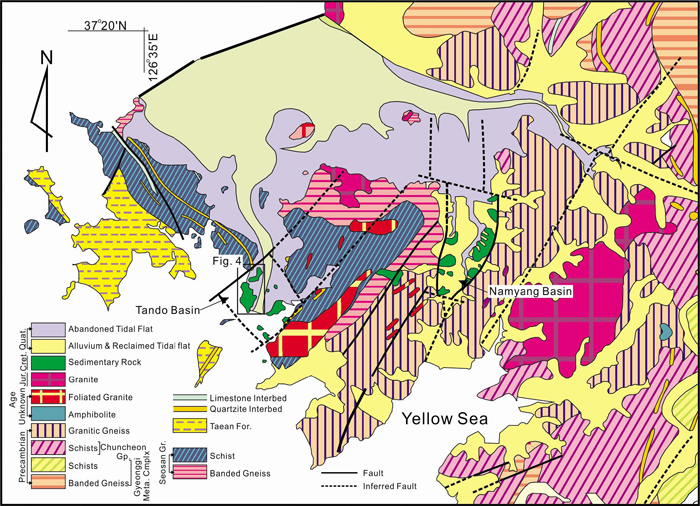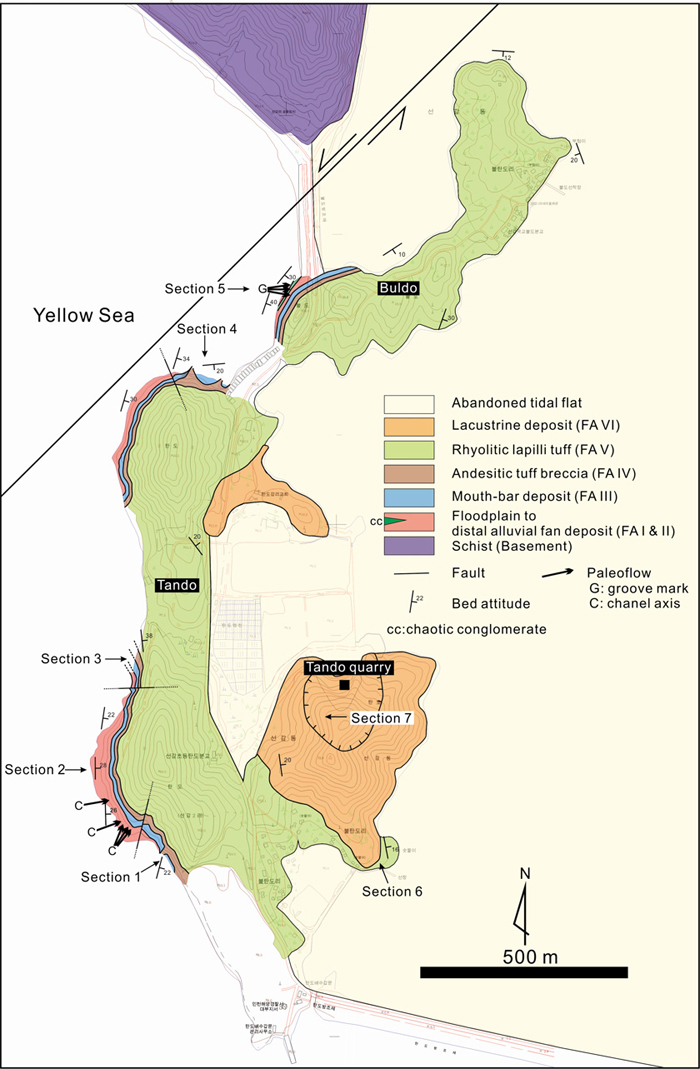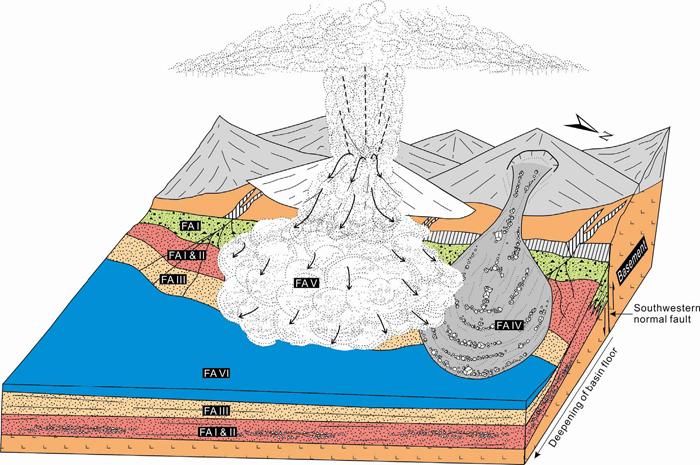
Depositional environment and basin development of the Cretaceous Tando Basin, mid-west Korea
This paper presents the results of the study of the depositional environment and basin development of the Cretaceous Tando Basin in the southwestern part of the Gyeonggi Massif. On the basis of the foliation form line and displacement of the basement rocks, the basin is interpreted as a rhomboidal pull-apart basin. The basinfill consists of 22 sedimentary facies that can be grouped into six facies associations (FA) based on constituent facies and bed geometry: (1) floodplain deposit (FA I), (2) alluvial-fan margin deposit (FA II), (3) mouth-bar deposit (FA III), (4) andesitic tuff breccia (FA IV), (5) rhyolitic lapilli tuff (FA V) and (6) lacustrine deposit (FA VI) in ascending order. Changes of depositional environments from subaerial (FA I & II) to subaqueous (FA III), followed by thick accumulation of volcaniclastic deposits (FA IV & V), suggest accelerating basin extension and subsidence together with huge volcanic eruptions. Offset stacking of the basinfill strata from the west to the east or northeast is indicative of migration of the depocenter into that direction, and suggests that the faults in the eastern part of the basin acted as a master fault for the basin development. This study of the Tando Basin can provide basic information of the previously unstudied sedimentary basins in the Gyeonggi Massif and can be used for a future study of the other Cretaceous sedimentary basins to the south of the Okcheon fold belt and the regional tectonic and crustal evolution of the Korean peninsula and NE Asia.
초록
이 논문은 경기육괴 서부에 분포하는 백악기 탄도분지의 퇴적환경과 분지발달 연구결과이다. 탄도분지는 분지 주변 기반암의 엽리궤적과 기반암의 변위를 통해 북서 및 남동 가장자리는 북동-남서 주향의 좌수향 주향이동단층, 북동 및 남서 가장자리는 북서-남동 주향의 정단층에 의해 구획된 마름모꼴 인리형 분지로 해석된다. 분지충전물에 대해 입자유형, 입자크기 그리고 일차 퇴적구조를 기준으로 총 22개의 퇴적상으로 구분하였고, 퇴적상 구성 및 층의 형태를 기준으로 하위로부터 (1) 충적평원 퇴적층(상조합 I), (2) 충적선상지 말단부 퇴적층(상조합 II), (3) 하구사주 퇴적층(상조합 III), (4) 안산암질 응회각력암(상조합 IV), (5) 유문암질 화산력 응회암(상조합 V), 그리고 (6) 호성 퇴적층(상조합 VI) 등 총 6개의 상조합으로 묶었다. 대기하 퇴적환경(상조합 I & II)에서 수중 퇴적환경(상조합 III)으로의 급격한 퇴적환경 변화와 두꺼운 화산쇄설암의 집적(상조합 IV & V)은 분지의 확장 및 침하의 가속과 함께 발생한 대규모 화산분출에 의해 분지가 빠르게 충전된 것으로 해석된다. 분지충전물이 서쪽에서 동 내지 북동방향으로 젊어져 퇴적중심지가 이 방향으로 이동했던 것으로 보이며, 이는 분지 동편의 단층들이 분지 발달의 주 단층으로 역할을 하였기 때문인 것으로 해석된다. 이 연구결과는 아직까지 연구가 미흡했던 경기육괴 지역 퇴적분지들에 대한 기초 자료를 제공할 뿐만 아니라, 향후 옥천대 이남 백악기 퇴적분지들과 함께 백악기 한반도 및 동북아시아의 지각진화와 조구조운동을 이해하는데 의미 있는 자료로 활용될 수 있을 것이다.
Keywords:
Gyeonggi Massif, Tando Basin, pull-apart basin, basin development, volcaniclast, 경기육괴, 탄도분지, 인리형 분지, 분지발달, 화산쇄설암1. 서 론
한반도에 분포하는 백악기 퇴적분지들 및 분지충전물(쇄설성 퇴적암 및 화산쇄설성 퇴적암)에 대한 세밀한 퇴적학적 연구와 분지해석은 주로 옥천대 이남의 음성분지, 진안분지, 영동분지, 격포분지, 경상분지 그리고 우항리층 등에서 수행되었으며(Chun and Chough, 1992; Chun and Kim, 1995; Kim et al., 1995, 1997, 2003; Jo et al., 1997; Ryang and Chough, 1997, 1999; Rhee et al., 1998; Lee and Chough, 1999; Sohn et al., 1999; Jo and Chough, 2001; Jeon and Sohn, 2003; Jo, 2003a, 2003b; Ryang, 2003; Sohn et al., 2005; Jeon and Sohn, 2008; Chough and Sohn, 2010) 이러한 결과들은 백악기 한반도 및 동북아시아의 지각구조진화와 조구조운동의 성격을 이해하는데 있어 중요한 자료로 사용되고 있다(Chough et al., 2000; Chough and Sohn, 2010). 이와 비슷한 또는 동일한 시기에 형성된 것으로 추정되는 소규모 퇴적분지들[탄도분지(Park et al., 2000), 남양분지(Kee et al., 2006a), 시화분지(Kim et al., 2009), 김포분지(Chwae et al., 1995), 천수만분지(Kee et al., 2011) 그리고 철원분지(Chwae et al., 1996) 등]이 한반도 경기육괴 서부지역에 분포하고 있지만, 남양분지를 제외한 나머지 분지들에 대한 분지충전물의 암상, 퇴적환경, 지질연대, 분지충전양상, 분지구조 그리고 분지진화에 대한 자료가 미흡한 실정이다. 최근 남양분지에 대한 퇴적-구조 연구결과는 경기육괴 서부지역의 퇴적분지(남-북 방향으로 발달한 우수향 주향이동단층에 의해 분지가 형성)는 옥천대 이남 지역의 퇴적분지(주로 북동-남서 방향으로 발달한 좌수향 주향이동단층을 따라 분지가 형성)와 상이한 단층방향과 운동감각에 의해 분지가 형성되고 성장하였음을 보여준다(Kee et al., 2006a). 이는 경기육괴와 옥천대 이남 지역의 분지들이 서로 다른 또는 독립적인 조구조운동 하에 형성되었음을 지시하며, 경기육괴의 소규모 퇴적분지에 대한 해석은 백악기 한반도 및 동북아시아의 정확한 지각운동특성 규명에 일조할 것으로 기대된다.
백악기 탄도분지(Park et al., 2000)는 북북동-남남서 주향의 당진 단층 이서에 위치하며(그림 1), 분지충전물은 남양만과 대부도를 연결하는 탄도, 불도 및 주변 작은 섬들에 나타난다. Park et al. (2000)은 탄도분지가 남-북 및 북동-남서 주향의 단층들에 의해 규제된 분지로 추정한 바 있으나, 이들 단층들에 대한 구체적인 지질학적 증거나 설명이 결여되어 있다. 현재 분지경계와 대부분의 분지충전물이 서해 및 현생 조간대 퇴적물 아래에 놓여 있어 정확한 분지의 규모, 형태 및 경계단층의 특성을 알기 어렵지만, 확인 가능한 분지충전물과 기반암의 분포 그리고 분지경계단층을 근거로 파악된 분지의 규모는 동-서 및 남-북 방향으로 최대 폭 약 4 km를 가지는 것으로 추정된다. 이 연구에서는 1) 탄도분지 주변 기반암의 엽리궤적과 기반암 변위를 바탕으로 분지경계단층의 특성, 분지 형태 및 분지유형을 파악, 2) 세밀한 지질도 작성을 통해 분지충전물의 분류, 3) 이들에 대한 퇴적상 분류와 상조합 분석을 통해 퇴적작용과 퇴적환경을 해석, 그리고 4) 탄도분지 최하부 자색 이암층에서 산출된 각룡류 공룡화석 기재와 원시 각룡류의 진화사와 동북아시아의 고지리적 의미 해석 등을 통해 탄도분지의 구조-층서 발달과 지구조적 의미에 대한 포괄적인 해석을 하고자 한다. 이러한 퇴적환경과 분지발달과정 해석은 아직 연구가 미흡한 경기육괴 지역 퇴적분지들에 대해 기초 자료를 제공해 줄 수 있을 뿐만 아니라, 백악기 한반도 및 동북아시아 지각진화 및 조구조운동을 이해하는데 있어 중요한 자료로 활용될 수 있을 것이다.
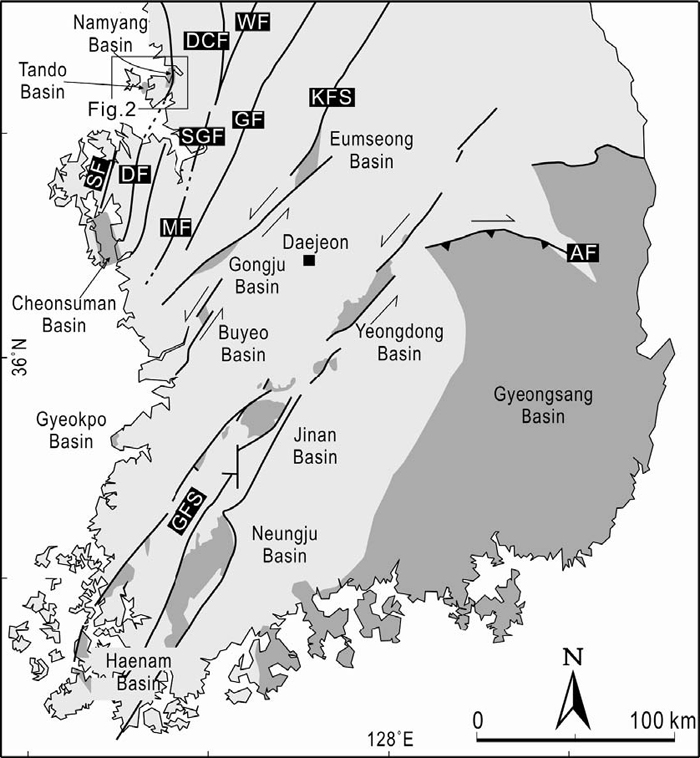
Distribution of Cretaceous sedimentary basins and major fault systems in the southern part of the Korean peninsula. Sedimentary basins below the Okcheon Belt developed along NE-SW-trending strike-slip faults, Kongju fault system (KFS) and Gwangju fault system (GFS), whereas others in the mid-west of the peninsula are closely associated with NNE-SSW-trending faults systems (modified after Chwae et al., 1996; Kee et al., 2006b, 2009; Chough and Sohn, 2010). AF, Andong fault; SF, Seosan fault; DF, Dangjin fault; MF, Musymcheon fault; GF, Gyeonggang fault; SGF, Singal fault; WF, Wangsukcheon fault; DCF, Dongducheon fault.
2. 지질개요
유라시아판 아래로 사각섭입하는 해양판(이자나기판)의 영향으로 인해 백악기에 한반도를 비롯한 동아시아 지역은 광범위한 좌수향 변형작용을 받게 되었고, 그 결과 한반도의 옥천대 이남 지역은 북동-남서 주향의 좌수향 주향이동성단층대(공주단층계, 광주단층계), 경기육괴는 남-북 내지 북북동-남남서 주향의 단층들(동두천단층, 포천단층, 왕숙천단층, 대광리단층, 동송단층 및 당진단층)을 따라 다양한 크기와 모양의 퇴적분지들이 형성되었다(Chough et al., 2000; Kee et al., 2009; 그림 1). Lee et al. (1999)은 대부도 1대 5만 지질도에서 백악기 응회질 퇴적암이 탄도, 불도 등 주변의 작은 섬들에 분포하고 있음을 처음으로 기재하였고, 이후 Park et al. (2000)은 이들 퇴적암이 분포하는 지역을 묶어 탄도분지로 명명하였다. Park et al. (2000)은 탄도분지가 남-북 내지 북동-남서 주향의 단층들에 의해 규제된 것으로 해석하였지만 이들 단층들에 대한 명확한 설명이 부족하여 탄도분지의 정확한 크기, 형태 및 유형을 파악하기 어려웠다.
탄도분지 주변 기반암은 경기편마암복합체의 각섬석-흑운모 편마암, 편암류, 화강편마암, 저변성 퇴적암인 태안층, 시대 미상의 엽리상 화강암과 각섬암 그리고 쥬라기 화강암 등으로 구성되어 있다(Lee et al., 1999; 그림 2). 태안층 내에는 석회암, 석회규산염암, 규암, 각섬암 등이 협재되어 있으며, 석회암 주변의 석회규산염암은 수 cm 두께의 성분대에 의해 호상 구조를 보인다. 편암류는 주로 분지의 북쪽과 동쪽에 그리고 태안층은 서쪽과 남쪽에 우세하게 분포하고 있다.
분지충전물은 남-북 내지 북동-남서 방향의 탄도와 불도의 서쪽 해안가 및 탄도에 위치한 탄도채석장 절개면에 잘 드러나 있으며, Park et al. (2000)은 이들 분지충전물들이 충적선상지-삼각주 환경하에서 퇴적된 것으로 해석한 바 있다. 지층은 N15oW, N-S, N45oE 등의 주향을 가지고 동쪽으로 약 20o 정도 경사져 있는데, 이러한 지층 자세는 분지의 서쪽에서 동쪽으로 갈수록 지층의 형성 시대가 젊어짐을 보여준다. 전반적인 지층의 경사값과 분지충전물의 분포를 고려해 볼 때, 분지충전물의 총 두께는 약 1.5 km 이상 달할 것으로 추정된다. 탄도분지 내 화산암의 K-Ar 전암연령은 79~89 Ma (Park et al., 2000; Choe et al., 2001)로 분지의 형성 시기를 후기 백악기로 보고하였으나, 최근 SHRIMP 저어콘 U-Pb 및 K-Ar 광물 연대측정 결과는 각각 112 Ma와 103 Ma로 분지 형성시기가 전기 백악기(Albian)임을 지시하고 있다(Kee et al., 2010).
3. 분지경계단층과 분지유형
기반암과 분지충전물과의 직접적인 경계가 없어 탄도분지의 경계단층 특성을 정확하게 파악하기 어렵지만 분지 주변 기반암의 엽리궤적 또는 엽리방향 그리고 기반암 변위를 통해 간접적으로 인지할 수 있다(그림 3). 분지 주변 기반암의 엽리는 북북동, 서북서, 북동-동북동 등 다양한 방향으로 보이고 있다(그림 3). 서쪽 경계부인 선감도-어섬 주변의 엽리궤적은 반복적인 ‘S’ 자형의 끌림현상, 동쪽 기반암 엽리궤적은 ‘V’ 자형으로 서로 어긋나 발달하고 있다(그림 3). 규암과 석회규산염암에 나타나는 엽리 방향은 어섬 부근에서는 남-북 방향을 보이다 인접지역인 고포리에서는 동-서 방향으로 바뀐다. 편암에 협재된 3매의 규암 모두는 북서-남동 방향을 보이다 분지 인접지역에서 남-북 방향으로 휘어져 전체적으로 ‘ㄱ’ 자형을 보이고 있다(그림 3). 신천리 지역에 나타나는 화강암은 북북동 주향의 구조선을 중심으로 서로 좌수향으로 어긋나 있는데, 이 구조선은 ‘V’ 자형 엽리궤적을 보이는 곳과 잘 일치한다(그림 2, 3). 분지의 북쪽과 남쪽은 분지충전물과 기반암과의 급격한 암상변화가 인지된다.
탄도분지의 서편과 동편에 나타나는 기반암 엽리궤적의 불연속성 그리고 규암과 엽리궤적의 휘어짐 현상은 분지의 서쪽과 동쪽경계를 규제하는 단층의 존재와 위치를 지시한다. 기반암과 분지충전물의 암상변화를 고려해 볼 때, 분지 서쪽의 경계단층은 Park et al. (2000)이 표시한 북동-남서 방향의 단층인 것으로 보인다. 이 단층을 중심으로 보여지는 ‘S’ 자형의 엽리궤적 반복현상과 규암의 ‘ㄱ’ 자형 휘어짐은 좌수향 주향이동단층운동 감각을 지시한다. 분지의 동편 기반암에 나타나는 ‘V’ 자형의 엽리궤적 및 화강암 분절은 분지의 서편 경계 단층과 평행한 방향과 동일한 운동감각의 단층이 존재함을 지시한다. 분지의 북쪽과 남쪽에 인지되는 급격한 암상변화는 이 지역에 북북서-남남동 방향의 단층이 존재함을 유추케 한다. 이 두 조의 단층은 주 단층인 좌수향주향이동 운동에 수반된 전단단층으로, 이들 사잇각이 60o~70o 를 유지하는 것으로 보아 주 단층에 대한 R’-전단단층으로 해석된다. 이상의 경계단층 특성은 탄도분지가 북동-남서 주향의 좌수향 주향이동단층과 이에 수반된 북서-남동 주향의 정단층에 의해 구획된 마름모꼴 인리형 분지(pull-apart basin)임을 보여준다.
4. 퇴적환경
분지충전물에 대해 입자유형(표생쇄설암 및 화산쇄설암), 입자크기 그리고 일차 퇴적구조 등을 기준으로 총 22 개의 퇴적상(sedimentary facies)으로 구분하였고(표 1), 퇴적상의 구성 및 층의 형태를 기준으로 하위로부터 (1) 충적평원 퇴적층(alluvial plain deposit), (2) 충적선상지 말단부 퇴적층(alluvial-fan margin deposit), (3) 하구사주 퇴적층(mouth-bar deposit), (4) 안산암질 응회각력암(andesitic tuff breccia), (5) 유문암질 화산력 응회암(rhyolitic lap-illi tuff), 그리고 (6) 호성 퇴적층(lacustrine depos-it) 등 총 6개의 상조합으로 묶었다(그림 4). 분지충전물의 남-북 내지 북동-남서 주향은 탄도(남-북)와 불도(북동-남서)의 장축 방향과 잘 일치하고 있어, 이들 방향은 지층의 측방변화를, 동 내지 남동쪽 방향은 지층의 수직변화를 나타낸다.
4.1 상조합 I: 충적평원 퇴적층
기재: 이 퇴적층은 현재 노출된 탄도분지의 최하부 암상 단위로 분지의 서쪽 해안가를 따라 남-북 방향으로 연장성 있게 나타나며(그림 4), 불도를 제외한 나머지 지점 또는 지역에서 암상, 층형 및 지층의 두께 변화 등은 관찰되지 않는다. 저조기에는 분지 서쪽으로 더 연장되어(층서적 하위 부분) 드러나나 기반암과의 경계를 확인할 수 없어 정확한 두께를 측정하기 어렵다. 이 퇴적층은 주로 보통 내지 불량한 분급의 자색 이질 사암과 이암(Zpu)으로 구성되어 있으며, 비조직상 역암(Cd), 포켓상 역암(Cpo), 자색 괴상 및 층상 사암(Sm-A & Ss-A) 그리고 유백색 내지 암회색 괴상 및 층상 사암(Sm-B & Ss-B) 등이 국부적으로 협재되어 나타난다(그림 5B). 이질 사암 및 이암(Zpu)은 주로 괴상 내지 수평 층리를 보이고 있으며, 다수의 석회질 단괴들이 발달해 있다(그림 6A). 또한 이 이암 내부에 생흔구조가 관찰되는 것으로 보고된 바 있다(Choe et al., 2001). 자색 사암(Sm-A & Ss-A)과 역암(Cpo)은 두께 0.3 m 미만으로 뚜렷하고 편평한 상하부 경계를 보이며 수 m 에서 수 십 m 의 폭을 가지며 측멸한다(그림 5). 일부 역암 하부에 발달한 도랑의 축의 방향은 N70oE 와 N80oE를 보인다(그림 4, 6B). 불도(지점 5)에는 이암(Zpu) 최상부에 측방 연장성이 좋은 유백색 사암(Sm-B & Ss-B)과 비조직상 역암(Cd)이 나타난다(그림 4, 6C). 이 사암의 하부 경계가 현생 조간대 퇴적물 및 충적층에 피복되어 정확하게 알 순 없지만, 주변 자색 이암과의 공간적 분포를 고려해 보면 수 m 이상의 두께를 가지는 것으로 추정된다. 비조직상 역암(Cd)은 최대 두께 5 m를 보이나 측방으로 두께가 점점 감소하며 수 십 m 폭을 가지며 측멸한다(그림 4). 역암의 하부 경계에는 여러 개의 홈자국(groove mark)이 발달하며, 이들은 N82oE, N80oW 그리고 E-W 방향을 보인다(그림 4, 6C). 이 역암은 아각형에서 아원형의 잔자갈에서 거력(최대 수 m 폭) 크기의 역들이 분급이 불량한 이질사 기질에 의해 입자지지 또는 기질지지 되어 있다. 역들은 주로 화강편마암, 안산암, 규암 그리고 자색 이암 및(역질) 사암으로 구성되어 있다. 특히 거력 크기의 자색 이암 및 사암 역들은 층의 상부에 집중되어 나타난다(그림 6D).
해석: 자색의 이질 사암 및 이암(Zpu)은 주로 육상의 충적평원에서 퇴적된 것으로 해석되어 왔다(Rhee and Chough, 1993; Khan et al., 1997; McCarthy et al., 1997; Jo, 2003b; Kim et al., 2009). 이러한 세립질 퇴적물들은 충적평원에 발생한 홍수류에 부유상태의 퇴적물이 빠르게 침전되고 퇴적되어 괴상의 퇴적체를 형성하며 부분적으로 발달하는 층리는 퇴적물이 침전된 직후 약하게 발달한 끌림작용에 의해 퇴적된 것으로 해석된다. 자색 이암 내에 부분적으로 보존된 생흔구조는 무퇴적 기간 동안 생물들이 활동이 왕성했음을 지시한다. 석회질 단괴는 퇴적 당시의 기후가 건조 내지 아건조 기후였고 퇴적이 활발하지 않은 기간 동안 대기 중에 퇴적물 노출되어 토양화 작용을 받았음을 지시한다. 이암 내에 협재된 얇은 판상 및 쐐기상 사암(Sm-A & Ss-A) 그리고 포켓상 역암(Cpo)은 간헐적으로 공급되는 조립질 홍수류에 의해 퇴적된 것으로 해석된다(Bromley, 1991; Rhee and Chough, 1993; Ryang and Chough, 1999; Ryang, 2003). 충적평원 퇴적층(상조합 I) 내에 충전선상지 말단부 퇴적층(상조합 II)이 협재되어 있는 점(아래 참조)을 고려해 볼 때, 이암 내에 협재된 조립질층(Sm-A, Ss-A & Cpo)은 분지의 가장자리에 발달한 충전선상지의 지류들이 홍수기에 분지 내부로 전진하여 퇴적된 것으로 해석된다(e.g., Nichols and Fisher, 2007). 측방 연장성이 좋은 유백색 내지 암회색 사암(Sm-B & Ss-B)은 충적평원에 발달한 호수 내지 습한 범람원에서 퇴적된 것으로 해석된다(Miall, 1977; Jo, 2003a). 두꺼운 비조직상 역암(Cd) 내의 퇴적암편은 분지충전물이 재퇴적 되었음을 지시하며, 이는 분지의 확장에 기인한 단층운동에 의해 분지충전물이 붕괴되어 역암을 형성한 것으로 해석된다(Badger and Watters, 2004).

Basin-bounding fault system and basin geometry based on the foliation form lines of the basement rocks and abrupt lithological changes. The Tando Basin is interpreted as a rhomboidal pull-apart basin, surrounded by sinistral strike-slip and normal faults.
4.2 상조합 II: 충적선상지 말단부 퇴적층
기재: 이 퇴적층은 상조합 I의 자색 이암 내에 협재된 조립질층으로 지점 2에서 가장 잘 관찰되며, 두 층간 경계는 급격한 암상의 변화(자색 이암에서 암갈색 역암으로 급격한 전이) 또는 침식면(최대 기복 약 3 m)에 의해 인지된다(그림 4, 5B, 7A). 이 퇴적층은 최대 두께 5 m로 측방(남-북 방향)으로 수 십 m 이상 연장성 있게 나타나나 전체적인 층의 두께는 점점 감소하여 상조합 I의 자색 이암(Zpu)으로 전이된다. 전반적으로 층의 하부에서 상부로 갈수록 개개 단위층의 두께와 역의 함량이 서서히 감소하는 상향 박층화-세립화 경향(thinning- and fining-up-ward trend)을 보여준다(그림 7A). 이 상조합은 주로 희미한 층상 역암/사암 호층(CSs), 층상 역질 사암(Ss-A) 그리고 괴상 역질 사암(Sm-A)으로 구성되어 있으며, 드물게 판상 역암(Csh), 무기질구조의 렌즈상 역암(Clo), 골사층리 역암(Ctx) 및 자색 이암(Zpu)을 포함한다(그림 5B). 각 암상단위의 층간구분은 침식적 하부 경계, 입자크기 변화 및 자색 이암의 협재에 의해 가능하다. 역암/사암 호층(CSs)은 잔자갈-왕자갈 크기 역들이 분급이 불량한 사질 기질에 역지지 내지 기질지지되어 있으며, 이들의 상부는 얇은 사암층(두께 <0.1 m)에 의해 피복되어 있기도 한다(그림 7B). 이 역암은 두께 약 0.5 m 미만의 판상 내지 쐐기상으로 하부 경계는 편평한 내지 약간 침식되어 있으며 상부는 편평 내지 위로 솟은 역들에 의해 약간 불규칙하다. 여러 매의 역암/사암 호층(CSs)이 뚜렷한 내부 침식면 없이 융합화 되어 두꺼운 층(두께 약 1 m)을 보이기도 한다. 판상 역암(Csh)은 두께 약 0.5 m 미만이며 층의 두께가 가장 두꺼운 중심부는 주로 잔자갈-왕자갈 크기 역들(일부 거력 포함)이 입자지지 되어 있으며, 층의 중심부에서 멀어질수록 층의 두께, 입자 크기 및 함량이 감소하는 경향을 보인다(그림 5B, 7C). 잔자갈-왕자갈 크기의 역들로 구성된 무기질구조의 역암(Clo)은 폭 약 1 m와 깊이 0.3 m 미만의 렌즈상을 보인다(그림 7D). 역암 하부의 침식곡 방향은 N24o ~ 40oE 이다(그림 4). 골사층리 역암(Ctx)은 잔자갈-왕자갈 크기 역들이 수 십 cm 깊이의 침식면을 충전하고 있다. 수 cm ~ 수 십 cm 두께의 역질 사암(Sm-A & Ss-A)은 역질층과 사질층이 뚜렷한 층간 경계 없이 교대로 나타나며, 괴상, (희미한) 층리, 그리고 저각의 사층리가 발달해 있다(그림 7E). 그리고 상위 역암의 침식 정도에 따라 판상 또는 쐐기상을 보인다. 조립질층 사이의 자색 이암(Zpu)은 두께 약 0.3 m 미만이며 상위 역암의 침식 정도에 따라 판상 및 쐐기상을 보이고 있다(그림 5B, 7B).
해석: 충적평원 이암(Zpu) 내에 협재된 역암 및 (역질) 사암층은 조립질 퇴적물의 운반이 가능한 상대적으로 큰 규모의 홍수류에 의해 퇴적된 것으로 해석된다(Bromley, 1991; Rhee and Chough, 1993; Kim et al., 1997, 2009; Ryang and Chough, 1999). 이들이 하도 형태 보다는 주로 판상의 층형을 보이는 점 그리고 층 내에 다양한 입자 분포를 보이는 점은 홍수류가 구획되어 있지 않은 형태로 빠르게 퇴적되었음을 지시한다(Blair, 1999a, b, 2000). 이러한 홍수류는 입자들의 밀도차에 의해 밑짐으로 운반되는 조립질의 하부층과 부유 운반되는 세립질의 상부층으로 구분되어 흘러가는데, 홍수류가 약해지는 과정에서 뜬짐으로부터 모래가, 밑짐이동에 의한 잔자갈의 퇴적이 반복되면서 층상의 역암/사암 호층(CSs)을 형성한 것으로 해석된다(Hogg, 1982; Blair, 1999b). 그리고 이러한 홍수류가 오랫동안 지속될 경우 내부 침식면 없이 여러 매의 역암/사암 호층이 융합되어 나타날 수 있다. 판상 역암(Csh)은 홍수류에 밑짐으로 운반되는 조립질의 역들이 유속의 감소에 의해 역들이 판상의 역질띠로 퇴적된 것으로 해석된다. 특히 이 역암 중심부의 상대적으로 조립질 역들은 이 부분이 홍수류의 유속이 가장 빠른 중심축이었음을 나타낸다. 조립질층과 세립질층의 불명확한 교대현상을 보이는 역질 사암층(Sm-A & Ss-A)은 상대적으로 세립질 입자로 구성된 홍수류의 내부 흐름이 연속적이지 못하거나 흐름의 요동(flow fluctuation)에 기인한 것으로 해석된다(Rhee and Chough, 1993). 역질 사암에 나타나는 괴상, 희미한 층리 그리고 저각의 사층리 구조(Sm-A & Ss-A)는 홍수류의 하부에 발달하는 견인밑층(traction carpet)의 뜬짐 낙하율(suspended-load fallout rate)의 변동에 의해 다양한 퇴적구조를 형성한 것으로 해석된다(Todd, 1989; Sohn, 1997). 렌즈상 역암(Clo) 및 골사층리 역암(Ctx)은 간헐적으로 발생한 소규모의 하도 지류(distributary chan-nel)에 의해 퇴적된 것으로 해석된다.
4.3 상조합 III: 하구사주 퇴적층
기재: 이 퇴적상은 충적평원 퇴적층(상조합 I)을 직접 피복하고 있으며, 서쪽 해안가를 따라 남-북 방향으로 일정한 두께(약 10 m)를 가지며 나타난다(그림 4). 유백색의 이 층은 하부 상조합 I의 자색 이암(Zpu)과 확연히 구분되며 이 둘의 경계는 급변적이다. 이 퇴적층 최상부의 사암층(Sm-B)은 부분적으로 자색을 띠거나 또는 내부에 수 mm 내지 수 cm 두께의 자색 이질층이 협재되어 있기도 한다(그림 5A). 이 퇴적상은 지점 1에서 전반적인 암상 및 퇴적구조를 잘 관찰할 수 있다(그림 4, 5A, 8A). 주로 점이층리 역암/사암 호층(CSg), 괴상 (역질) 사암(Sm-B), 층상 사암(Ss-B) 등으로 구성되어 있으며, 부분적으로 괴상 역암(Cm), 점이층리 사암(Sn), 처어트(CH) 및 괴상 화산력 응회암(mLT)이 포함된다(그림 5A). 각 암상들은 뚜렷한 하부 경계를 가지고 횡적으로 수 십 m 이상 연장되어 나타나며 여러 개의 소규모 로브들이 중첩되어 횡적으로 성장하고 있다(그림 8B).
점이층리 역암/사암 호층(CSg)은 두께 약 0.2 ~ 0.8 m 미만으로 하부의 역질층과 상부의 사질층으로 구분되는 정점이 층리 또는 층의 중간에 역질층이 분포하는 역-정점이 층리를 보여준다(그림 5A). 역질층과 사질층의 경계는 점이적이다. 역질층은 주로 잔자갈 크기의 역들이 분급이 불량한 사질 기질에 의해 기질지지 또는 입자지지 되어있으며, 괴상에서 희미한 층리를 보여준다. 역질층의 하부 경계는 편평하거나 침식적이며, 종단면상에서 수 m 이상 연장성을 보이나 측방으로 소멸되거나 역들이 감소하여 사질층으로 전이된다. 사질층은 중립사에서 극조립사로 구성되어 있으며, 괴상에서 희미한 층리를 보인다. 괴상 역암(Cm)은 두께 약 0.3 m 미만으로 잔자갈 크기의 역들이 분급이 불량한 사질 기질에 의해 기질지지 되어 있다(그림 5A, 8B). 하부 경계는 뚜렷하고 비침식적이다. 괴상 내지 희미한 층상 사암(Sm-B & Ss-B)은 두께 약 1 m 미만으로 뚜렷한 상-하부 경계를 갖고 측방으로 수 m 이상 연장되어 나타나나 주로 급하게 소멸하여 렌즈상 또는 쐐기상을 보인다(그림 5A, 8B). 주로 세립사에서 잔자갈 크기의 역들로 구성되어 있으며 분급은 보통 내지 불량한 편이다. 부분적으로 과대력(outsized clast)을 포함하기도 한다. 두께 약 0.3 m 미만의 점이층리 사암(Sn)은 양호한 분급의 중립사에서 조립사로 구성되어 있으며, 하부 경계는 편평하고 약간 침식적이다. 수 mm 에서 수 십 cm 두께의 처어트(CH)는 뚜렷한 하부 경계를 갖고 횡적으로 수 십 m 이상 연속성 있게 발달하고 있다(그림 5A, 8B). 이 퇴적층의 최상부에 협재된 괴상 화산력 응회암(mLT)은 두께 약 1 m 미만으로 아래 사암의 침식 정도에 따라 측방 두께 변화를 보인다(그림 5A). 주로 조립사에서 잔자갈 크기의 부석편, 암편(자색 이암편) 그리고 결정편들이 세립의 화산회 기질에 지지되어있으며 분급은 불량하다.
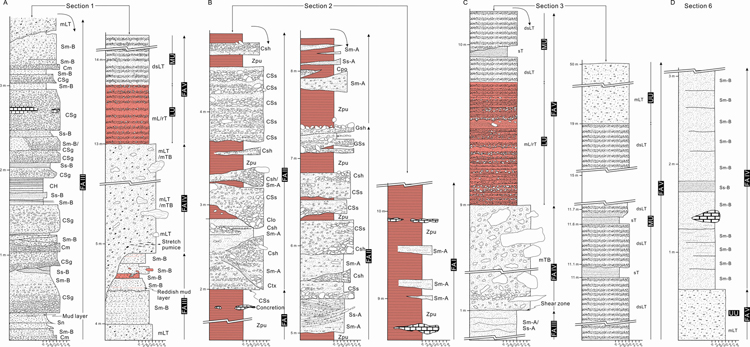
Columnar logs of the Tando Basin. See Figure 4 for the locations of the logs and Table 1 for brief description and interpretation of sedimentary facies.
해석: 아래 자색의 충적평원 퇴적층(상조합 I)과 급격한 암색(유백색) 변화를 보이는 이 퇴적층은 서로 다른 퇴적환경하에서 퇴적되었음을 나타내며, 유백색의 암색은 퇴적물을 구성하고 있는 광물들이 공기와의 접촉이 낮아 쉽게 산화되기 않는 수중에서 퇴적되었음을 지시한다. 저각의 지층 경사를 갖는 로브들의 중첩과 횡적성장은 이 퇴적층이 저각의 선상지 삼각주인 하구사주에서 퇴적되었음을 지시한다(Dunne and Hempton, 1984; Wood and Ethridge, 1988). 침식적인 하부 경계를 보이는 점이층리 역암/사암 호층(CSg)은 주로 하부의 고농도 저탁류와 이들의 상부 또는 후미에 발달하는 저농도 저탁류 두 부분으로 구성된 복합류에 의해 퇴적된 것으로 해석된다(Postma et al., 1988; Sohn et al., 2002). 반면 비침식적인 하부 경계를 갖는 괴상 역암(Cm)은 쇄설류에 의해 퇴적된 것으로 해석된다(e.g., Johnson, 1984). 다양한 퇴적구조의 사암층(Sm-B, Ss-B & Sn)은 저탁류에서 퇴적속도 또는 뜬짐 낙하율의 변동에 기인한 것으로 해석된다(Lowe, 1982; Kim et al., 1995). 사암층에 협재된 처어트(CH)는 호수물의 증발과 강우 동안 호수의 pH의 증감에 의해 물속에 녹아있던 실리카 성분이 침전되고 퇴적된 것으로 해석된다(Chough et al., 1996). 따라서 이 시기의 분지 주변부에는 산성질 화산활동이 활발이 일어나 실리카 성분을 쉽게 공급할 수 있었고, 일부 화산쇄설물이 유입되어 화산력 응회암(mLT)을 퇴적시킨 것으로 보인다.
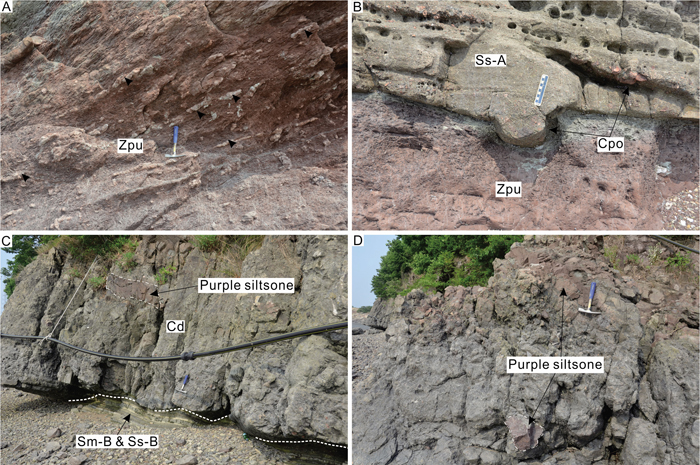
Depositional features of FA I. (A) Purple siltstone (Zpu) with calcareous nodules (black arrow). (B) Gravel pockets (Cpo) and stratified sandstone (Ss-A) overlying purple siltstone (Zpu). A gravel pocket shows a small hollow- fill or gutter cast at the base. (C & D) Bedded sandstone (Sm-B & Ss-B) and chaotic conglomerate (Cd) in Buldo area.
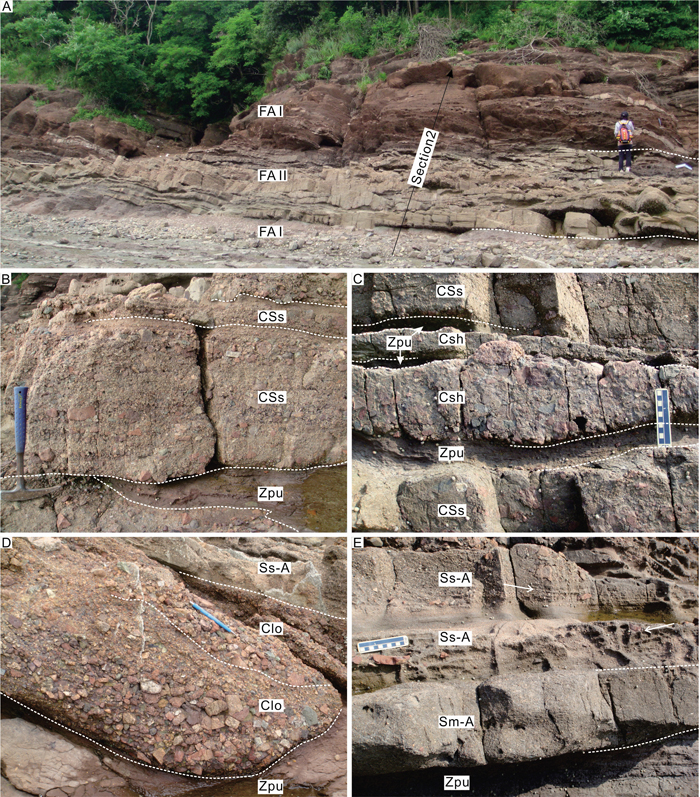
Depositional features of FA II. (A) Overview of FA II deposit, overall thinning and fining upwards. (B) Crudely stratified conglomerate/sandstone couplets (CSc) with wedge-shaped purple siltstone (Zpu). (C) Gravel sheets (Csh) are thicker and coarse-grained in the center of the beds. (D) Small channel-fill conglomerate with tightly clast-supported texture (Clo) and an overall fining-upward trend (E) Massive (Sm-A) to low-angle cross-stratified (Ss-A) sandstones with bi-directional cross-stratification (white arrows).
4.4 상조합 IV: 안산암질 응회각력암
기재: 이 퇴적층은 두께 약 8 m (최대 10 m)의 비조직상 응회각력암(mTB)으로 구성된 단일 암상으로, 아래 하구사주 퇴적층(상조합 III)의 층리면과 나란하게(남-북 방향) 분지전역에 나타나고 있다(그림 4, 8A). 일부 지역들(지점 1, 3, 4)에서는 응회각력암이 아래 상조합 III 사암을 아수직(약 30o~ 40o) 내지 수직(약 80o) 방향으로 단절한 요지(trough; 폭 < 10 m와 깊이 <3 m)형태를 보이기도 한다(그림 4, 9A,B). 응회각력암은 각형에서 아각형의 왕모래-거력(최대 직경 4 m) 크기의 부석편, 결정편 그리고 암편들이 세립의 화산회 기질에 입자지지 또는 기질지지 되어있으며, 분급은 불량하다. 응회각력암 중 상대적으로 세립질 입자들로 구성된 곳에서 녹색의 신장된 부석편들이 관찰된다(그림 9C, D). 암편은 화강편마암, 안산암, 상조합 I 기원의 자색 이암, (역질) 사암 및 탄산염 단괴, 암회색 이암 그리고 안산암질 (화산력) 응회암, 결정편은 사장석, 흑운모 그리고 불투명광물로 구성되어 있다. 거력 크기의 퇴적암편의 내부 층리는 교란 또는 변형되어 있으며, 이들은 응회각력암 층리면에 아수직 내지 수직 방향으로 가로지르며 나타나기도 한다(그림 9E). 응회각력암의 하부 경계는 대체로 뚜렷하고 비침식적 또는 침식적으로 지점에 따라 다양하게 나타나며, 하부 경계를 따라 수 cm(최대 10 cm) 두께의 전단대(shear zone)가 발달해 있다(그림 9F).
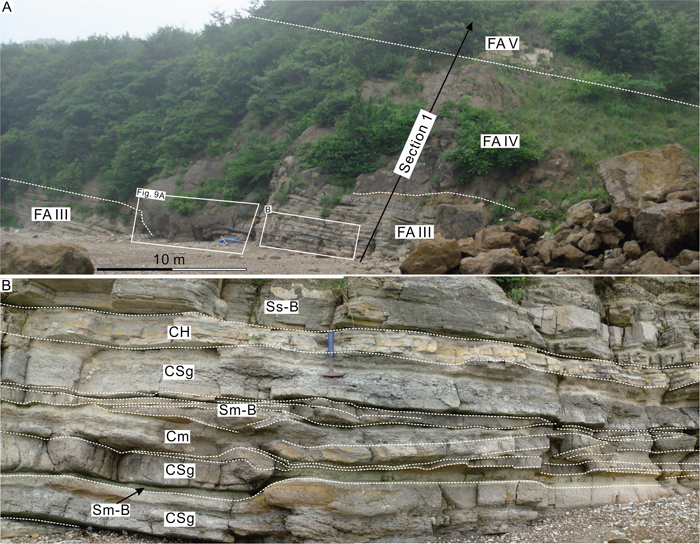
(A) Abrupt lithological changes from mouth-bar deposit (FA III) through volcanic landslide deposit (FA IV) to pyroclastic deposit (FA V) at section 1. (B) The FA III deposit is composed of several stacked lobes with distinct lower and upper boundaries.
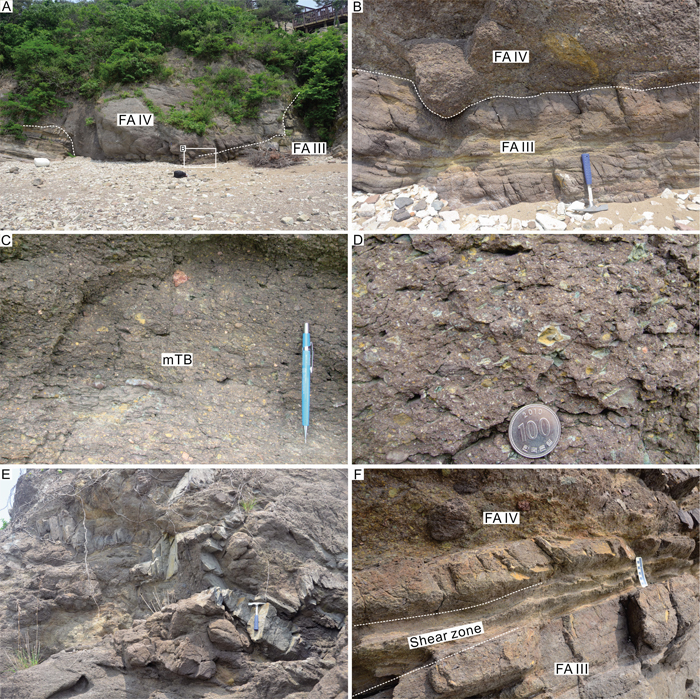
Depositional features of FA IV. (A, B) A tuff breccia (FAIV) is cutting into the underlying mouth-bar deposit (FA III) with a partly subvertical contact. (C,D) Close-up view of relatively fine-grained part of the tuff breccia, consisting of granule- to fine pebble-sized clasts with partly stretched pumice (greenish color). (E) Highly distorted siltstone blocks within the tuff breccia. (F) Thin shear zone (about 0.1 m thick) at the base of the tuff breccia (FA IV).
해석: 다양한 종류(화산암에서 퇴적암) 및 크기의 암편을 포함하고 있는 아주 두꺼운 비조직상의 응회각력암은 화산쇄설물과 분지충전물이 뒤섞여 운반되고 퇴적되었음을 지시하며, 이는 분지의 확장과 관련된 화산분출과 구조운동으로 인해 화산쇄설물로 구성된 화산 사면과 분지충전물이 동시에 붕괴되어 퇴적된 것으로 해석된다(cf. 신수도 diamictite; Chough and Sohn, 2010). 국부적으로 아래 퇴적층을 단절하며 나타나는 특징은 퇴적동시성 함몰에 의해 생긴 곡부를 응회각력암이 충전한 결과로 해석된다.
4.5 상조합 V: 유문암질 화산력 응회암
기재: 분지충전물의 대부분을 차지하는 이 암상은 분지 전체에 광범위하게(탄도, 불도 그리고 석산) 나타나며, 지층의 분포와 경사값을 고려해 볼 때 약 140 m 이상의 두께를 가지는 것으로 추정된다(그림 4). 이 암상은 암색 및 퇴적상 구성에 따라 크게 3개의 퇴적단위(하부, 중부, 상부)로 구분되며, 이들의 수직적인 변화 양상은 지점 3에서 잘 관찰된다(그림 5C, 10A).
상조합 IV의 응회각력암을 피복하고 있는 하부단위는 두께 약 0.7 m로 괴상 화산력층(mL)과 암자색 층상 응회암(sT)이 다양한 두께로 교호하면서 나타난다(그림 10B). 괴상 화산력층(mL)은 두께 0.1 m 미만으로 왕모래-잔자갈 크기의 부석편, 암편 그리고 결정편들이 세립의 화산회에 입자지지 내지 무기질 구조를 보여주고 있으며, 분급은 보통 내지 양호하다(그림 10B). 암편은 각진 화강편마암과 편암, 결정편은 사장석과 석영으로 구성되어 있다. 각 층은 수 십 m 폭의 노두에서 뚜렷한 두께변화 없이 횡적으로 잘 연장되어 나타나나, 일부 하부 경계는 화산력 크기의 암편 또는 부석편에 의해 층리가 아래로 오목하게 휘어진 하중구조(loading structure)가 발달하기도 한다(그림 10C). 층상 응회암(sT)은 수 mm에서 수 cm 두께의 분급이 양호한 세립질-조립질 응회암으로 구성되어 있으며, 이 두 암상이 뚜렷한 경계를 가지고 교대로 반복되거나 점이적으로 입자크기가 감소하는 정점이층리를 보여준다(그림 10B, C). 이 응회암은 아래 화산력층(mT)의 불규칙한 상부를 피복하고 있으며, 뚜렷한 두께변화 없이 측방으로 잘 연장되어 나타난다.
중부단위는 두께 약 9 m로 주로 희미한 층상 화산력 응회암(dsLT)으로 구성되어 있으며, 부분적으로 층상 응회암(sT)이 협재되어 나타난다(그림 10D). 유백색의 중부단위는 암자색의 하부단위와 야외에서 쉽게 구분되며, 이 두 단위의 경계는 점이적이다. 화산력 응회암(dsLT)은 협재된 층상 응회암(sT)에 의해 수 십 cm에서 최대 4 m 두께의 아단위(subunit)으로 구분된다(그림 10D). 화산력 응회암(dsLT)은 화산력이 풍부한 조립질층과 화산회로 구성된 세립질층이 다양한 두께로 호층을 이루고 있으며 두 층간의 경계는 불명확하다(그림 10E). 조립질층은 중립사-잔자갈 크기의 결정편(석영, 장석), 암편(화강편마암, 편암) 그리고 부석편들이 세립의 화산회 기질에 입자지지 내지 기질지지 되어있으며, 분급은 불량하다. 잎사귀 형태의 암편들은 층리면에 아평행 내지 평행하게 배열되어 있다. 층상 응회암(sT)은 두께 0.1 m 미만으로 분급이 양호한 세립질 화산회로 구성되어 있으며, 뚜렷한 상-하부 경계를 가지고 횡적으로 잘 연장되어 나타난다.
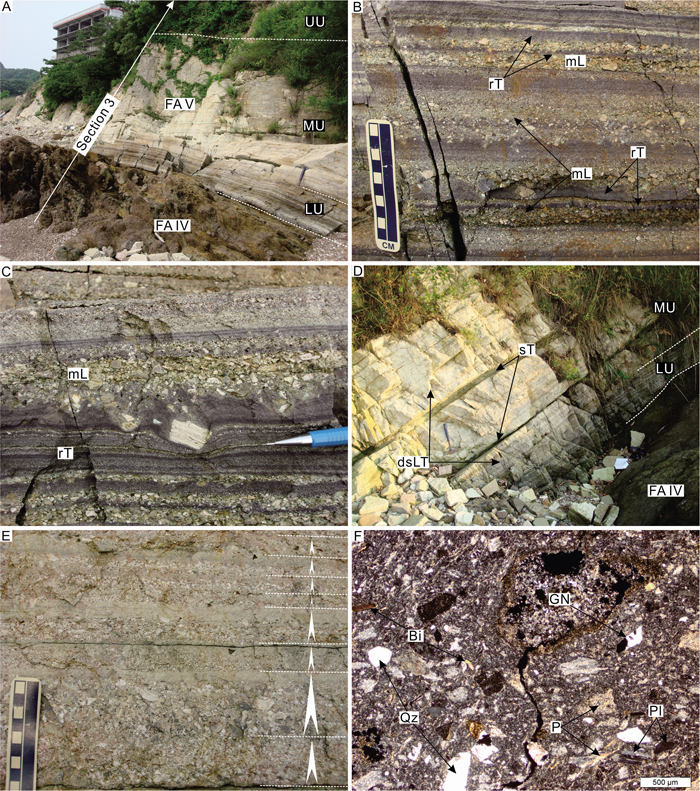
Depositional features of FA V. (A) Pyroclastic deposit (FA V) at section 3 is divided into three depositional units (LU, MU & UU) by lithofacies change. White arrow represents a logging section. (B) Lower unit (LU) consists of lapillistone (mL) and reddish tuff (rT). The thin reddish tuff with good lateral continuity is draping an irregular upper surface of the lapillistone. (C) Downward loading of pebble-sized clast in the lower lapillistone (mL) caused deformation of the underlying layers (rT). (D) Middle unit (MU) is mostly composed of diffuse-stratified lapilli tuff (dsLT) with minor stratified tuff (sT). (E) Close-up of diffuse-stratified lapilli tuff (dsLT) of MU, consisting of lapilli-rich and lapilli-poor couplets with indistinct contacts between them. (F) Thin-section photomicrograph of massive lapilli tuff (mLT) of upper unit (UU) under open nicols, composed of crystals [quartz (Qz), plagioclase (Pl), biotite (Bi)], pumice (P) and lithic fragments [granite gneiss (GN)] in a fine vitric ash matrix.
이 암상의 대부분을 차지하는 상부단위(두께 약 >100 m)는 괴상 화산력 응회암(mLT)으로 구성되어 있으며, 아래 층상 화산력 응회암(dsLT)과의 경계는 점이적이다(그림 10A). 괴상 화산력 응회암(mLT)은 조립사-잔자갈 크기의 부석편, 암편(화강편마암, 편암) 그리고 결정편(석영, 장석)들이 세립의 화산회 기질에 지지되어 있으며, 분급은 불량하다(그림 10F).
해석: 하부단위의 괴상 응회암(mT)의 다음과 같은 특징, 1) 양호한 분급의 세립질 화산회, 2) 점이층리 구조, 3) 얇은 층의 두께와 우수한 횡적 연장성, 4) 불규칙한 화산력층(mL)의 상부를 피복하는 특징, 등은 이 응회암이 물속에서 부유하던 세립질의 화산회가 빠르게 낙하-침전되어 퇴적되었음을 지시한다. 응회암(mL) 사이의 화산력층(mL)은 물속으로 공급된 다양한 크기의 암편들이 수력학적 분급작용(hydrological sorting)을 거치면서 조립질 암편만을 선별적으로 퇴적시킨 것으로 해석된다. 화산력층 하부에 발달하는 하중구조는 무거운 암편들이 미고화된 화산회층에 떨어지거나 지속적으로 누적된 암편들의 하중에 의해 형성된 것으로 해석된다. 하부단위의 두께(0.7 m 미만)를 고려해 볼 때, 이 단위의 퇴적시기에 호수의 수심은 아주 얕았던(수 m 미만) 것으로 추정된다. 얇은 두께의 화산력층과 응회질층의 반복적인 교호는 작은 규모의 비지속적인 분출 펄스로 구성된 화산쇄설성 밀도류가 호수 위를 지나가면서 화산쇄설물을 공급한 결과로 해석된다.
다양한 내부 퇴적구조의 변화를 가지는 불량한 분급의 화산력 응회암(dsLT & mLT)은 주로 지속적이면서도 내부에는 수많은 펄스를 갖고 있는 화산쇄설성 밀도류의 점진적인 누적(progressive aggradation)에 의해 형성되는 것으로 해석된다(Branney and Kokelaar, 1992, 1997, 2002; Bursik and Woods, 1996; Dade and Huppert, 1996). 이런 화산쇄설성 밀도류에 의해 생성되는 여러 퇴적구조는 뜬짐 낙하율(suspended-load fallout rate)의 변화와 퇴적 경계층(flow-boundary zone)의 특성에 의해 결정되는 것으로 알려져 있다(Druitt, 1998; Branney and Kokelaar, 2002). 조립질층과 세립질층이 교호하는 희미한 층상 화산력 응회암(dsLT)은 밀도류 내에 발달하는 난류에 의해 입자들의 분리작용은 받았으나 이들 내부에는 입자들의 밑짐이동이 미약하여 층리는 잘 발달하지 못하였음을 지시한다(Branney and Kokelaar, 2002). 층상 화산력 응회암(dsLT)에 나타나는 조립질층과 세립질층의 다양한 두께변화는 밀도류가 불규칙한 난류의 뜬짐 낙하율의 변동에 기인한 것으로 해석된다(Branney and Kokelaar, 2002). 화산력 응회암(dsLT) 사이의 층상 응회암(sT)은 개개 분출 펄스 세기의 감소에 의해 화산쇄설성 밀도류의 상부 또는 후미에 발달하던 세립질 화산회들이 부유 낙하와 밑짐이동에 의해 퇴적된 것으로 해석된다(Branney and Kokelaar, 2002; Sohn et al., 2005). 희미한 층상 화산력 응회암(dsLT)에서 괴상 화산력 응회암(mLT)로의 변화는 화산쇄설성 밀도류의 퇴적 경계층의 특성과 뜬짐 낙하율의 변화를 지시하는데, 두꺼운 괴상 화산력 응회암(mLT)은 뜬짐으로 운반되던 화산쇄설물이 빠르게 낙하-침전하여 퇴적된 것으로 해석된다(Branney and Kokelaar, 2002).
4.6 상조합 VI: 호성 퇴적층
기재: 이 퇴적층은 탄도분지의 최상위 암상으로 분지의 동편에 분포하고 있으며, 분지 동남부의 탄도채석장(약 두께 70 m)에 잘 나타나고 있다(지점 7; 그림 4, 11A). 현재 분지의 동편은 조간대 퇴적물에 피복되어 정확한 분포를 알 수 없지만, 층서적으로 수 백 m의 층 두께를 가질 것으로 추정된다. 주로 횡적 연장성이 좋은 괴상 내지 희미한 층리의 (역질) 사암(Sm-B & Ss-B)과 이암(Mm)으로 구성되어 있다(그림 5D, 11B). 이들 사암 및 이암 내에서 조각류 공룡발자국화석이 보고된 바 있다(Choe et al., 2001).
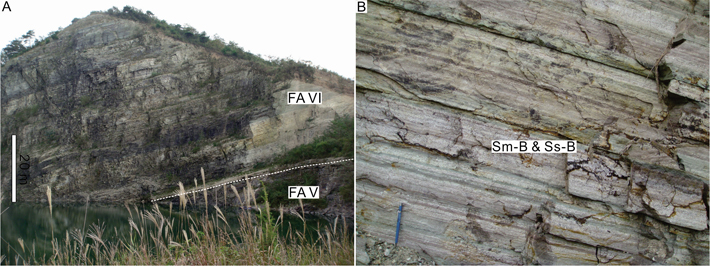
Depositional features of FA VI. (A) Contact between pyroclastic deposit (FA V) and lacustrine deposit (FA VI) at section 7. (B) The FA VI deposit is mostly composed of massive to stratified sandstones (Sm-B & Ss-B) with good lateral continuity.
해석: 횡적 연장성이 좋은 사암(Sm-B & Ss-B)은 저농도 저탁류에 의해 퇴적된 것으로 해석된다(Lowe, 1982; Kim et al., 1995). 괴상 이암(Mm)은 저농도 저탁류 내에 부유하던 세립질 퇴적물들이 빠르게 낙하-침전하여 퇴적된 것으로 해석된다. 퇴적층 내의 공룡발자국 화석은 공룡의 이동성이 용이한 얕은 수심의 호수였던 것으로 해석된다.
5. 화 석
2001년 탄도분지 내 탄도채석장(상조합 VI; 그림 2)에서 수 개의 조각류 공룡발자국 흔적이 발견되었으나 이들에 대한 연구는 미비한 실정이며 현재 안산시청이 보관 중이다(Choe et al., 2001). 2008년 5월 30일 화성시 탄도제방의 한 전석에서 공룡 골격화석이 발견되었고(그림 12A), 화석처리 결과 다수의 뼈가 제 위치에 보존되어있는 공룡 하반신 골격이었다(그림 12B; Kee et al., 2010). 절단된 다리뼈와 깨어진 전석의 형태로 보아 채석 당시 공룡의 상반신도 보존되어 있었을 가능성이 크나 탄도제방은 시화호의 개발과 함께 1994년 완성되었기 때문에 나머지 상반신 화석이 채굴도중 훼손되었는지 아니면 다른 전석에 포함되어 어디에 묻혀있는지 현재로선 확인할 수 없다.
발견된 공룡화석은 원시각룡류(basal neoceratopsian)에 속하며 새로운 신종으로 밝혀져 코리아케라톱스 화성엔시스(Koreaceratops hwaseongensis)로 명명되었다(Lee et al., 2011). 각룡류 공룡(ceratopsians)은 한반도에서 처음으로 발견된 것으로 기존 우리나라에서 발견된 수많은 공룡발자국으로도 그 존재가 확인된 적이 없는 공룡이다. 코리아케라톱스는 꼬리뼈의 추체(centrum)보다 5배나 긴 신경배돌기(neural spine)가 발달하며, 뚜렷한 능선으로 구분되는 거골(astragalus)은 경골(tibia)의 medial malleolus와 lateral malleolus가 확고하게 연결될 수 있도록 두 개의 얕은 공간이 발달해 있다. 삼각형 모양의 근골(calcaneum)은 위에서 보았을 때, 거골보다 앞뒤로 1.5배나 더 길다. 코리아케라톱스를 포함해 총 19개의 각룡류를 대상으로 136개의 골격학적 특징을 분석한 결과, 코리아케라톱스는 계통발생학적으로 Archaeoceratops (You and Dodson, 2003; Dong and Azuma, 2007)와 Cerasinops (Chinnery and Horner, 2007) 중간에 위치하는 것으로 나타났다(그림13).
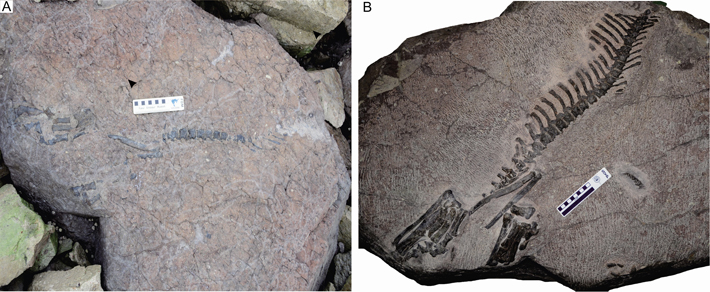
(A) Nneoceratopsian dinosaur bones found in FA I sandstone block at the rock-filled Tando embankment dam in 2008. (B) A ventral view of the specimen (KIGAM VP 200801) after preparation. The proximal tibiae and fibulae were sharply cut off at the edge of the block.
Lee et al. (2011)은 진화된 각룡류에 있어 커다란 머리뼈와 뿔의 발달은 이족보행에서 사족보행으로 걸음걸이가 변화하는데 밀접한 관계가 있음을 지적하였다. 즉 머리뼈 길이와 발을 포함한 뒷다리 길이의 비율은 Cornosauria에서 0.7 이상이나 덜 진화된 이족보행의 Psittacosaurus와 Cerasinops에서는 0.4 이하이다. Montanoceratops, Prenoceratops, Leptoceratops의 비율은 0.6에서 0.65로 나타나며 이는 이들 원시 각룡류가 이족보행과 사족보행의 각룡류들 사이의 중간 걸음걸이를 가졌음을 지시한다. 코리아케라톱스는 Cerasinops보다 더 원시적인 종이기 때문에 아마도 이족보행을 했을 것으로 추정된다. 따라서 이 공룡뼈 화석은 이족보행에서 사족보행으로 진화하는 원시 각룡류 진화사에 중요한 역할을 할 수 있을 뿐 아니라 고지리적으로도 유라시아 대륙에서 가장 동쪽에 산출되었다는 특징도 갖는다(Kee et al., 2010; Lee et al., 2011).
6. 분지진화
탄도분지를 충전하고 있는 다양한 쇄설성 퇴적암(상조합 I, II, III & VI)과 화산쇄설성 퇴적암(상조합 IV & V)은 분지충전물이 분지의 구조운동과 이에 수반된 화산활동에 의해 형성되었음을 지시한다(Bahk and Chough, 1996; Janecke et al., 1997; Mueller and Corcoran, 2001; Aranda-Gomez et al., 2003; Son et al., 2005; Busby and Bassett, 2007; Jeon and Sohn, 2008; Jeong et al., 2008; Kwon and Sohn, 2008; Chough and Sohn, 2010; Kwon et al., 2011a, 2011b). 현재 분지경계단층을 따라 발달하는 분지충전물은 해수면 및 충적층 아래에 놓여있거나 삭박되어 분지의 구조운동과 관련된 암상의 측방변화 양상은 알 수 없다. 하지만 뚜렷한 수직 암상변화는 분지의 구조운동과 화산활동에 대한 주요한 퇴적환경 변화 및 지층발달과정을 나타낸다.
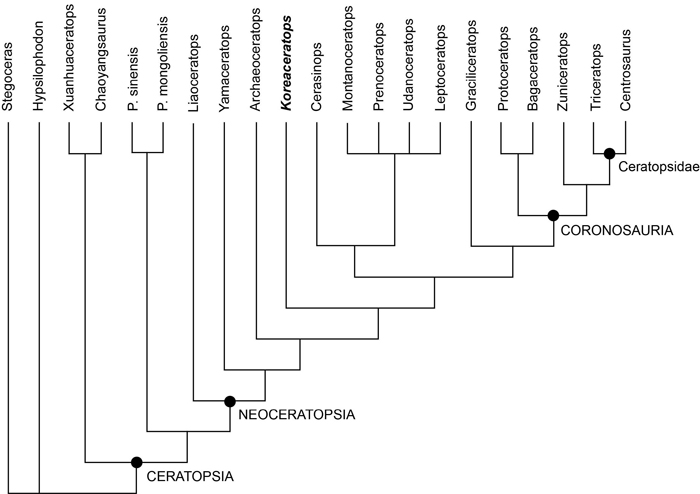
Strict consensus of four most parsimonious trees resulting from analysis of the 136 characters, 21 taxa matrix (Tl=241, CI=0.672, RC=0.527, RC=0.785) to show a phylogenetic position of Koreaceratops.
남-북 방향의 지층 주향 그리고 서쪽에서 동 내지 북동-남동 방향으로의 지층 젊어짐은 분지의 퇴적시스템과 퇴적공간이 점진적으로 동 내지 북동-남동 방향으로 확장하였고, 분지 바닥이 이 방향으로 기울어졌음을 지시한다. 분지 서쪽 가장자리를 따라 암상 및 층의 두께 변화 없이 연속적으로 분포하는 자색 이암(상조합 I)은 분지형성 초기의 분지 내부는 바닥이 편평한 충적평원을 형성하고 있었음을 지시한다. 자색 이암 내에 나타나는 충적선상지 말단부 퇴적층(상조합 II)은 간헐적으로 발생한 큰 규모의 홍수류에 의해 분지 내 충적평원으로 조립질 퇴적물이 전진퇴적 한 것으로 해석된다. 역암의 하도축이 북동 및 동북동 방향을 보이는 점(그림 4) 그리고 조립질층이 주로 탄도의 지점 2에 우세하게 나타나는 점은 상조합 II 역암에 횡적으로 대비되는 조립질 퇴적시스템이 주로 분지 남서쪽에 발달하고 있었던 것을 추론케 한다. 이는 분지형성 초기 주 단층(좌수향 주향이동단층) 사이에 발달하는 분지 남서쪽 정단층의 구조운동이 미약하거나 거의 활동하지 않아 조립질의 퇴적시스템이 분지 내부로 유입되는 통로 역할을 하였던 것으로 해석된다(e.g., Gawthorpe and Leeder, 2000). 반면, 불도 남서쪽(지점 5) 지역에서 충적평원 퇴적층(상조합 I) 상부에 나타나는 호성 퇴적층(Sm-B & Ss-B)은 분지가장자리의 저지대를 따라 호수 및 습한 범람원을 형성하고 있었음을 지시하며, 이러한 저지대 형성은 분지 북서쪽 주 단층인 주향이동단층의 단층운동에 기인한 것으로 해석된다. 그리고 호성 퇴적층(Sm-B & Ss-B) 상위의 두꺼운 비조직상 역암(Cm)은 주 단층의 전파열개에 수반된 분지충전물의 사태 또는 지표붕괴에 기인한 것으로 해석된다.
충적평원 퇴적층(상조합 I)에서 하구사주 퇴적층(상조합 III)으로의 퇴적환경변화는 분지경계단층들의 침강으로 인해 분지 바닥이 빠르게 깊어져 호성환경으로 바뀌었음을 보여준다. 분지 형성 초기의 분지바닥이 (북)동쪽으로 깊어지는 점 그리고 상조합 III 퇴적층이 분지의 서쪽에 우세하게 분포하는 점은 퇴적물이 분지의 서쪽에서 공급된 것으로 보인다. 상조합 III에 급경사진 삼각주 전면부 퇴적층이 나타나지 않는 점 그리고 지역별 또는 지점별로 퇴적양상 및 지층의 두께변화 없이 연속적으로 나타나는 점은 이 지역의 분지 바닥이 완만한 저각의 선상지 삼각주를 형성하였고, 이는 분지 서편의 주향이동단층과 이에 수반된 정단층의 구조운동은 미약하여 뚜렷한 지형적 기복을 형성하지 못했던 것으로 해석된다.
쇄설성 퇴적암 상위에 분포하는 두꺼운 화산쇄설암(상조합 IV & V)의 집적은 분지의 확장과 이에 수반된 화산활동의 시작과 증가에 기인한 결과로 해석된다(Bahk and Chough, 1996; Mueller and Corcoran, 2001; Aranda-Gomez et al., 2003; Son et al., 2005; Busby and Bassett, 2007; Jeon and Sohn, 2008; Jeong et al., 2008; Kwon and Sohn, 2008; Chough and Sohn, 2010; Kwon et al., 2011a). 탄도분지 내부에 화산형성과 관련된 구조(예, 화산 지형, 화구주변에 분포하는 용암류, 각력암, 암맥 및 환형 단층 등)의 결핍은 분지 내에 화산쇄설물을 공급한 화산은 분지 외부에 발달하고 있었던 것으로 추론된다. 최근 Lee et al. (2004)은 분지 서쪽 상조합 I 퇴적층 내의 탄화된 유기물은 일차적인 유기물이 화산활동에 기인한 열변질 작용에 의한 것으로 해석한 바 있다. 이는 분지의 서쪽 외부에 화산이 존재하고 있었음을 유추케 하며, 분지 서쪽 단층대를 따라 열수를 쉽게 공급할 수 있었던 것으로 보인다. 상조합 IV의 응회각력암에 산재해 있는 안산암편, 안산암질 (화산력) 응회암편 및 동 기질은 이 화산쇄설물이 성인적으로 관련이 있는 동 화산에서 공급되었음을 지시한다. 일반적으로 안산암질 용암류와 화산쇄설물의 반복적인 집적은 (급)경사진 사면을 형성하는 화산(성층화산)을 형성하는 것으로 알려져 있다(Sigurdsson et al., 2000). 따라서 분지의 확장 동안 화산분출과 구조운동은 급경사진 화산 사면과 분지충전물의 사태를 야기시켜 다량의 화산쇄설물이 분지를 빠르게 충전할 수 있었던 것으로 사료된다(그림 14). 분지충전물의 대부분을 차지하고 있는 화산쇄설성 퇴적층(상조합 V) 내에 이들의 재동 퇴적상, 고토양층 및 부정합면(내부 침식면)이 나타나지 않는 점은 충분한 퇴적공간의 형성으로 인해 화산쇄설물이 지표에 노출될 시간 없이 빠르게 매몰되었음을 지시하며, 이 시기에 가장 활발한 분지바닥의 침강과 확장을 하였던 것으로 해석된다. 상조합 V가 지층의 주향(남-북) 방향으로 두께변화 및 암상변화 없이 횡적으로 연장성 있게 나타나는 특징 그리고 주향이동단층을 따라 나란히 분포하는 점(불도)은 서쪽에서 공급된 화쇄쇄설성 밀도류가 북동-남서 주향의 경계단층에 형성된 지형적 기복의 영향을 받으며 동쪽으로 흘러 퇴적된 것으로 추론된다(Jeong et al., 2008). 화산쇄설성 퇴적층(상조합 V) 상위의 두꺼운 호성 퇴적층(상조합 VI)은 화산활동 이후에도 분지바닥의 침강과 확장은 지속되어 호성분지를 재 형성할 수 있었던 것으로 해석된다. 호성 퇴적층에서 발견된 공룡발자국 화석은 공룡들이 활동하기 좋을 정도의 얕은 수심의 호수였고, 이와 같은 미고결 상태의 호성퇴적층은 다량의 수분을 가지고 있어 공룡들이 알을 부화하고 새끼를 기르는 서식지(주로 충적평원)로서 부적합 하여 인접한 남양분지(시화분지)에서 발견된 공룡 둥지 화석은 발견되지 않는 것으로 보인다(cf. Kim et al., 2009 ).
지속적인 동 내지 북동-남동 방향으로의 지층 경동 및 젊어짐, 퇴적시스템 및 퇴적중심지의 이동 그리고 호성퇴적층의 분포 등은 분지바닥이 이 방향으로 깊어지는 비대칭형 분지구조를 형성하고 있었음을 지시하며, 분지 동편에 위치한 주향이동단층과 정단층이 분지의 퇴적공간 발달에 주 단층으로서 역할을 하였던 것으로 판단된다.
7. 토 의
인리형 분지의 분지경계 단층시스템은 주향이동단층과 이 사이에 안행상 배열을 보이는 수 매의 소규모 정단층이 각각 전파열개하여 운동학적으로 그리고 기원적으로 연계된 하나의 분지를 형성한다(Dooley and McClay, 1997; Rahe et al., 1998). 전세계에 발달하고 있는 다양한 크기의 현생 인리형 분지들에 대한 연구 결과는(Aydin and Nur, 1982), 오랜 기간 동안 발달한 전형적인 인리형 분지의 길이와 폭의 비는 거의 일정한 약 3의 값을 보이는 것으로 알려져 있다(Mann et al., 1983; Mann, 2007). 최근 Kwon et al. (2011b)은 분지의 길이와 폭의 비가 약 1을 보이는 마이오세 어일분지를 미성숙 인리형 분지(immatured pull-apart basin)로 해석하였다. 또한 인리형 분지의 전형적인 지층패턴(주 단층을 따라 상향조립화와 후층화 반복)이 나타나지 않는 것은 주향이동단층 사이에 발달하는 정단층이 분지형성 및 퇴적시스템 발달에 주요한 역할을 하였기 때문으로 해석하였다. 분지의 길이와 폭의 비가 약 1인 점, 분지충전물의 상향조립화와 후층화 결핍 그리고 비대칭형 분지구조 등의 이유로 탄도분지가 어일분지와 같은 미성숙 인리형 분지로 해석되는데, 이는 주 단층뿐만 아니라 이에 수반된 정단층도 분지형성에 주요한 역할을 하였기 때문으로 판단된다.
한반도에 분포하는 백악기 분지들의 층서 및 구조해석은 당시의 한반도뿐만 아니라 동북아시아의 지체구조발달을 이해하는데 중요한 자료로 활용되어 왔다(Chough et al., 2000). 한반도 백악기 분지들에 대한 세밀한 퇴적환경 및 분지진화 연구는 주로 옥천대 이남에 발달하고 있는 분지들에서 이루어져 왔으며, 이 분지들은 북동-남서 주향의 좌수향 주향이동단층계에 의해 형성된 것으로 보고되고 있다(Chun and Chough, 1992; Rhee and Chough, 1993; Chun and Kim, 1995; Kim et al., 1995, 1997, 2003; Jo et al., 1997; Ryang and Chough, 1997, 1999; Rhee et al., 1998; Lee and Chough, 1999; Chough et al., 2000; Jo, 2003a, 2003b; Ryang, 2003; Chough and Sohn, 2010). 하지만 한반도와 동중국 사이에 위치하고 있는 경기육괴 서부지역은 한반도와 중국 대륙 간 지질학적 연계성에 있어 중요한 지리적 위치를 하고 있음에도 불구하고, 이 지역에 나타나는 백악기 분지들(탄도분지, 남양분지, 시화분지, 천수만분지, 철원분지 및 김포분지)에 대한 개별적 및 체계적인 연구는 드물었다. 최근 들어 경기육괴 지역이 동북아시아 지체구조운동 발달사에 있어 중요성이 대두되면서 이 지역에 분포하는 퇴적분지들에 대한 세밀한 퇴적환경, 분지진화 그리고 지질연대에 대한 연구결과가 점진적으로 진행되고 있다(Kee et al., 2006a, 2006b, 2009, 2010, 2011; Kim et al., 2009). 특히 남양분지(시화분지) 및 철원분지는 남-북 방향으로 발달한 우수향 주향이동단층계에 의해 형성된 것으로 보고되고 있어(Chwae et al., 1996; Kee et al., 2006a; Kim et al., 2009), 옥천대 이남 분지들과 다른 분지경계단층의 방향과 단층의 운동감각을 보인다. 이는 백악기 동안 경기육괴와 옥천대 이남은 서로 다른 또는 독립적인 지각운동의 영향하에 놓였음을 지시한다. 경기육괴에 분포하는 백악기 분지들이 남-북 내지 북북동-남남서 주향 방향의 단층들에 연하여 분포하는 점을 고려해 볼 때, 이들 단층들은 백악기 한반도 분지 형성과 확장에 중요한 역할을 하였을 것으로 사료된다(그림 1). 하지만 이들 단층계에 대한 정확한 분포, 전체연장, 활동시기 및 운동감각 등에 대한 자료가 미비한 상태이다. 향후 백악기 경기육괴 지역 및 한반도 지각운동 특성을 이해하기 위해서는 북북동-남남서 주향 방향 단층들의 구조적 특성뿐만 아니라, 이들 단층들에 의해 형성된 분지들에 대한 구체적인 연구(예, 퇴적환경, 분지구조, 지질연대, 지화학, 고지자기, 화석 등)와 종합적인 해석이 이루어져야 할 것이다.
탄도분지와 인접한 남양분지(시화분지)에서의 자기층서는 약 111 Ma로 보고되고 있어(Hwasung City, 2005), 탄도분지(약 110 Ma; Kee et al., 2009)와 거의 동일한 시기에 형성된 것으로 해석된다. 동 시기 및 공간적 인접성 그리고 동일한 지구조 운동하에 영향을 받았음에도 불구하고, 이 두 분지의 분지경계단층의 방향 및 운동감각(좌수향 대 우수향 주향이동운동)은 서로 다르다. 이 두 분지의 기반암이 선캠브리아기 편마암류임을 고려해본다면, 분지 형성이전 광역 변성작용에 의해 기반암에 발달한 엽리 및 벽개 등의 방향들이 분지발달에 중요한 요소로 작용하지 않았을까 추론된다. 하지만 이를 뒷받침 할 지질학적 자료는 부족하며 분지주변 기반암의 변성구조에 대한 체계적인 연구가 추후 실시되어야 할 것으로 판단된다. 탄도분지의 남쪽에 분포하는 천수만분지(약 109 Ma)는 북북서-남남동 방향으로 발달한 정단층에 의해 형성된 여러 개의 곡부(trough)를 충전한 결과로 해석하였으며(Kee et al., 2011), 이는 상기 두 분지와 또 다른 분지진화과정을 보여준다. 따라서 백악기 경기육괴는 시공간적으로 복잡한 지구조운동 영향하에 놓였을 것으로 사료되나 아직까지 뚜렷한 결론 없이 연구자의 개별적인 연구 및 논의가 진행되고 있는 실정이다. 따라서 추후 경기육괴 지역에 분포하는 분지들이 지구조적으로 어떠한 진화과정을 겪었는지를 해석하기 위해 다학제적 연구(구조, 퇴적, 지화학, 연대측정, 고지자기 등)가 반드시 이루어져야 할 것이다. 이번 탄도분지의 연구결과는 향후 백악기 경기육괴와 한반도 지구조운동 복원에 있어 의미 있는 기초 자료로 활용할 수 있을 것이다.
8. 결 론
백악기 탄도분지는 경기육괴를 북북동-남남서 방향으로 가로지르는 단층계의 이서에 위치하고 있으며, 분지 주변 기반암의 엽리궤적 및 기반암이 변위 분석 결과 분지의 북서 및 남동 가장자리는 북동-남서 주향의 좌수향 주향이동단층, 북동 및 남서 가장자리는 북서-남동 주향의 정단층에 의해 구획된 마름모꼴의 분지 형태를 보이고 있다. 분지의 길이와 폭/길이 비(약 1) 그리고 분지충전양상(경계단층을 따라 반복적인 지층 상향조립화와 후층화 결핍) 등을 고려해 볼 때 탄도분지는 미성숙형 인리형 분지로 해석된다. 분지충전물은 하위로부터 (1) 충적평원 퇴적층(상조합 I), (2) 충적선상지 말단부 퇴적층(상조합 II), (3) 하구사주 퇴적층(상조합 III), (4) 안산암질 응회각력암(상조합 IV), (5) 유문암질 화산력 응회암(상조합 V), 그리고 (6) 호성 퇴적층(상조합 VI)으로 구성되어 있으며, 이들의 수직적인 암상변화는 점진적인 분지의 확장과 이에 수반된 화산분출에 의해 분지가 형성되었음을 보여준다. 동 내지 북동쪽 방향으로의 지층 경동 및 젊어짐, 퇴적시스템 및 퇴적중심지의 이동 그리고 호성퇴적층의 분포 등은 분지바닥이 이 방향으로 기울어져 있었음을 나타내며, 이는 분지 동편의 주향이동단층과 정단층이 분지 형성 및 퇴적공간 발달에 주 단층으로서의 역할을 하였던 것으로 해석된다. 퇴적층에서 측정된 도량의 축 방향(동 내지 북동 방향), 분지충전물의 공간적 분포(주로 분지 서편에 우세하게 분포하고 동쪽으로 갈수록 젊어짐) 그리고 분지 내 화산 구조의 부재 등은 분지에 공급된 퇴적물과 화산쇄설물은 분지 외부 남서쪽에서 주로 공급된 것으로 판단되며, 당시에는 이 지역에 큰 화산체들이 존재하였던 것으로 추정된다(그림 14). 이상의 탄도분지의 분지충전양상은 동시기에 형성된 인근 남양분지(주로 충적선상지와 충적평원 퇴적층으로 구성; Kee et al., 2006a; Kim et al., 2009)와 비교해 볼 때, 분지의 크기는 작지만 아주 다이나믹한 분지의 구조운동과 화산활동을 겪었던 것으로 해석된다. 따라서 탄도분지의 분지진화사는 경기육괴에 분포하는 퇴적분지들에 대한 화산-퇴적-구조 발달에 대한 모델을 제시해주고 향후 백악기 한반도 및 동북아시아 지체구조발달을 이해하는데 기초자료로 활용될 수 있을 것으로 사료된다.
Acknowledgments
본 연구는 한국지질자원연구원의 주요사업인 ‘서부경기육괴 지구조 진화 및 지질정보구축(과제번호: GP2011-004)’ 과제의 일환으로 수행되었다. 야외에서 유익한 조언을 해주신 경상대 손영관 교수님께 깊이 감사 드립니다. 본 논문에 유익한 심사의견을 주신 전북대 양우헌 교수님과 공주대 권이균 교수님께도 깊이 감사 드립니다.
References
-
J.J. Aranda-Gomez,, J.F. Luhr,, T.B. Housh,, C.B. Connor,, T. Becker,, C.D Henny,, Synextensional Pliocene-Pleistocene eruptive activity in the Camargo volcanic field, Chihuahua, Mexico, Bulletin of the Geological Society of America, (2003), 115, p298-313.
[https://doi.org/10.1130/0016-7606(2003)115<0298:SPPEAI>2.0.CO;2]

-
A. Aydin,, A Nur,, Evolution of pull-apart basins and their scale independence, Tectonics, (1982), 1, p91-105.
[https://doi.org/10.1029/TC001i001p00091]

-
T.C. Badger,, R.J Watters,, Gigantic seismogenic landslides of Summer Lake basin, south-central Oregon, Geological Society of America Bulletin, (2004), 116, p687-697.
[https://doi.org/10.1130/B25333.1]

- J.J. Bahk,, S.K Chough,, An interplay of synand intereruption depositional processes: the lower part of Jangki Group (Miocene), SE Korea, Sedimentology, (1996), 43, p421-438.
-
T.C Blair,, Cause of dominance by sheetflood vs. debris-flow processes on two adjoining alluvial fans, Death Valley, California, Sedimentology, (1999a), 46, p1015-1028.
[https://doi.org/10.1046/j.1365-3091.1999.00261.x]

-
T.C Blair,, Sedimentary processes and facies of the waterlaid Anvil Spring Canyon alluvial fan, Death Valley, California, Sedimentology, (1999b), 46, p913-940.
[https://doi.org/10.1046/j.1365-3091.1999.00259.x]

-
T.C Blair,, Sedimentology and progressive tectonic unconformities of the sheetflood-dominated Hell's Gate alluvial fan, Death Valley, California, Sedimentary Geology, (2000), 132, p233-262.
[https://doi.org/10.1046/j.1365-3091.1999.00259.x]

-
M.J. Branney,, B.P Kokelaar,, A reappraisal of ignimbrite emplacement: progressive aggradation and changes from particulate to non-particulate flow during emplacement of high-grade ignimbrite, Bulletin of Volcanology, (1992), 54, p504-520.
[https://doi.org/10.1007/BF00301396]

-
M.J. Branney,, B.P Kokelaar,, Giant bed from a sustained catastrophic density current flowing over topography: Acatlan ignimbrite, Mexico, Geology, (1997), 25, p115-118.
[https://doi.org/10.1130/0091-7613(1997)025<0115:GBFASC>2.3.CO;2]

- M.J. Branney,, B.P Kokelaar,, Pyroclastic Density Currents and the Sedimentation of Ignimbrites, Geological Society, London, Memoir 27, (2002), 143.
-
M.H Bromley,, Architectureal features of the Kayenta Formation (Lower Jurassic), Colorado Plateau, USA, Sedimentary Geology, (1991), 73, p77-99.
[https://doi.org/10.1016/0037-0738(91)90024-8]

-
M.I. Bursik,, A.W Woods,, The dynamics and thermodynamics of large ash flows, Bulletin of Volcanology, (1996), 58, p175-193.
[https://doi.org/10.1007/s004450050134]

- C.J. Busby,, K.N Bassett,, Volcnic facies architecture of an intra-arc strike-slip basin, Santa Rita Mountains, Southern Arizona, Bulletin of Volcanology, (2007), 70, p85-103.
-
B.J. Chinnery,, J.R Horner,, A new neoceratopsian dinosaur linking North American and Asian taxa, Journal of Vertebrate Paleontology, (2007), 27, p625-641.
[https://doi.org/10.1671/0272-4634(2007)27[625:ANNDLN]2.0.CO;2]

- M.Y. Choe,, H.R. Jo,, J.I. Lee,, S.D. Hur,, K.S Jeong,, Investigations on the geology and subsurface remains in the abandoned tidal flats (Daebu Island area) of Sihwa Lake, Ansan city, (2001), p101, (in Korean).
-
S.K. Chough,, S.B. Kim,, S.S Chun,, Sandstone/chert and laminated chert/black shale couplets, Cretaceous Uhangri Formation (southwest Korea): Depositional events in alkaline lake environments, Sedimentary Geology, (1996), 104, p227-242.
[https://doi.org/10.1016/0037-0738(95)00130-1]

-
S.K. Chough,, S.T. Kwon,, J.H. Ree,, D.K Choi,, Tectonic and sedimentary evolution of the Korean peninsula: a review and new view, Earth-Science Reviews, (2000), 52, p175-235.
[https://doi.org/10.1016/S0012-8252(00)00029-5]

-
S.K. Chough,, Y.K Sohn,, Tectonic and sedimentary evolution of a Cretaceous continental arc-backarc system in the Korean peninsula: New view, Earth-Science Reviews, (2010), 101, p225-249.
[https://doi.org/10.1016/j.earscirev.2010.05.004]

-
S.S. Chun,, S.K Chough,, Depositional sequences from high-concentration turbidity currents, Cretaceous Uhangri Formation (SW Korea), Sedimentary Geology, (1992), 77, p225-233.
[https://doi.org/10.1016/0037-0738(92)90128-E]

- S.S. Chun,, S.B Kim,, The Cretaceous Kyokpori Formation, SW Korea: sublacustrine steep-sloped delta facies, Journal of Geological Society of Korea, (1995), 31, p215-236.
- W.C. Chwae,, S.J. Choi,, K.H. Park,, K.B Kim,, Geological report of the Cheolwon-Majeonri sheet (1:50,000), Korea Institute of Geology, Mining and Materials, (1996), p31, (in Korean with English abstract).
- W.C. Chwae,, G.B. Kim,, S.J. Choi,, Y. Uk,, M.S Jin,, Geological report of the Kimpo-Incheon sheets (1:50,000), Korea Institute of Geology, Mining and Materials, (1995), 34, p34, (in Korean with English abstract).
-
W.B. Dade,, H.E Huppert,, Emplacement of the Taupo ignimbrite by a dilute turbulent flow, Nature, (1996), 381, p509-512.
[https://doi.org/10.1038/381509a0]

- Z.M. Dong,, Y Azuma,, On a primitive neoceratopsian from the Early Cretaceous of China, In: Dong, Z.M. (ed), Sino-Japanese Silk Road Dinosaur Expedition, (2007), China Ocean Press, Beijing, p68-89.
- T. Dooley,, K McClay,, Analog modeling of pull-apart basins, American Association of Petroleum Geologists Bulletin, (1997), 81, p1804-1826.
-
T.H Druitt,, Pyroclastic density currents, In: Gilbert, J.S. and Sparks, R.S.J. (eds.), The Physics of Explosive Volcanic Eruptions. Geological Society, London, Special Publication, (1998), 1456, p145-182.
[https://doi.org/10.1144/GSL.SP.1996.145.01.08]

-
L.A. Dunne,, M.R Hempton,, Deltaic sedimentation in the Lake Hazar pull-apart basin, south-eastern Turkey, Sedimentology, (1984), 31, p401-412.
[https://doi.org/10.1111/j.1365-3091.1984.tb00868.x]

-
R.L. Gawthorpe,, M.R Leeder,, Tectono-sedimentary evolution of active extensional basins, Basin Research, (2000), 12, p195-218.
[https://doi.org/10.1111/j.1365-2117.2000.00121.x]

-
S.E Hogg,, Sheetfloods, sheetwash, sheetflow or...?, Earth-Science Reviews, (1982), 18, p59-76.
[https://doi.org/10.1016/0012-8252(82)90003-4]

- Hwasung City, Report on the preservation and characteristics of the dinosaur egg fossil localities in Hwasugn City, Gyeonggi-do, (2005), p172, (in Korean).
- S.U. Janecke,, B.F. Hammond,, L.W. Snee,, J.W Geissman,, Rapid extension in an Eocene volcanic arc: Structure and paleogeography of an intra-arc half graben in central Idaho, Geological Society of America Bulletin, (1997), 109, p253-267.
-
Y.M. Jeon,, Y.K Sohn,, Sedimentary characteristics and stratigraphic implications of the Kusandong Tuff, Cretaceous Gyeongsang Basin, Korea, Geosciences Journal, (2003), 7, p53-64.
[https://doi.org/10.1007/BF02910265]

- Y.M. Jeon,, Y.K Sohn,, Characteristics, emplacement processes, and stratigraphic implications of the basalts intercalated in the Hayang Group, Cretaceous Gyeongsang Basin, SE Korea, Journal of the Geological Society of Korea, (2008), 44, p707-727, (in Korean with English abstract).
-
J.O. Jeong,, C.W. Kwon,, Y.K Sohn,, Lithofacies and architecture of a basinwide tuff unit in the Miocene Eoil Basin, SE Korea: Modes of pyroclastic sedimentation, changes in eruption style, and implications for basin configuration, Geological Society of America Bulletin, (2008), 120, p1263-1279.
[https://doi.org/10.1130/B26077.1]

- H.R Jo,, Depositional environments, architecture, and controls of Early Cretaceous non-marine successions in the northwestern part of Kyongsang Basin, Korea, Sedimentary Geology, (2003a), 161, p269-294.
-
H.R Jo,, Non-marine successions in the northwestern part of Kyongsang Basin (Early Cretaceous): Fluvial styles and stratigraphic architecture, Geosciences Journal, (2003b), 7, p89-106.
[https://doi.org/10.1007/BF02910212]

-
H.R. Jo,, S.K Chough,, Architectural analysis of fluvial sequences in the northwestern part of Kyongsang Basin (Early Cretaceous), SE Korea, Sedimentary Geology, (2001), 144, p307-334.
[https://doi.org/10.1016/S0037-0738(01)00123-3]

-
H.R. Jo,, C.W. Rhee,, S.K Chough,, Distinctive characteristics of a streamflow-dominented alluvial fan deposit: Sanghori area, Kyongsang Basin (Early Cretaceous), southeastern Korea, Sedimentary Geology, (1997), 110, p51-79.
[https://doi.org/10.1016/S0037-0738(96)00083-8]

- A.M Johnson,, Debris flow. In: Brunsden, D. and Prior, D.B. (eds.), Slope Instability, John Wiley & Sons, Chichester, (1984), p257-361.
- W.S. Kee,, B.C. Kim,, Y.N Lee,, Sedimentary environments and structural evolution of the Cretaceous Namyang Basin, Korea, Journal of the Geological Society of Korea, (2006a), 42, p329-351, (in Korean with English abstract).
- W.S. Kee,, H.J. Koh,, S.W. Kim,, B.C. Kim,, Y.B. Kim,, Y.H. Kim,, H.C. Kim,, S.I. Park,, K.Y. Song,, M.J. Lee,, S.R. Lee,, Y.S. Lee,, Y.N. Lee,, D.L. Cho,, B.Y Choi,, S.J. Choi,, W.C. Chwae,, J.H Hwang,, Tectonic evolution of upper crustal units in the mid-western part of the Korean peninsula, Korea Institute of Geosicence and Mineral Resources, (2009), p259, (in Korean with English abstract).
- W.S. Kee,, H.J. Koh,, S.W. Kim,, B.C. Kim,, Y.B. Kim,, Y.H. Kim,, H.C. Kim,, S.I. Park,, K.Y. Song,, S.R. Lee,, Y.S. Lee,, Y.N. Lee,, H.J. Lee,, H.Y. Jeon,, D.L. Cho,, B.Y. Choi,, S.J. Choi,, W.C. Chwae,, J.H Hwang,, Tectonic evolution of upper crustal units in the mid-western part of the Korean peninsula, Korea Institute of Geosicence and Mineral Resources, (2010), 242, (in Korean with English abstract).
- W.S. Kee,, H.J. Koh,, S.W. Kim,, B.C. Kim,, Y.B. Kim,, Y.H. Kim,, H.C. Kim,, S.I. Park,, K.Y. Song,, S.R. Lee,, Y.S. Lee,, Y.N. Lee,, H.J. Lee,, D.L. Cho,, B.Y. Choi,, S.J. Choi,, W.C. Chwae,, J.H Hwang,, Tectonic evolution of upper crustal units in the mid-western part of the Korean peninsula, Korea Institute of Geosicence and Mineral Resources, (2011), p255, (in Korean with English abstract).
- W.S. Kee,, D.R. Cho,, B.C. Kim,, K.M Jin,, Geological report of the Pocheon sheet (1:50,000), Korea Institute of Geosicence and Mineral Resources, (2006b), p66, (in Korean with English abstract).
-
I.A. Khan,, J.S. Bridge,, J. Kappelman,, R Wilson,, Evolution of Miocene fluvial environments, eastern Potwar plateau, northern Pakistan, Sedimentology, (1997), 44, p221-252.
[https://doi.org/10.1111/j.1365-3091.1997.tb01522.x]

-
B.C. Kim,, K.M. Yu,, H.Y. Chun,, S.J. Choi,, Y.B Kim,, The southeastern margin of the Cretaceous Yongdong Basin, Korea: a lacustrine fan-delta system, Geosciences Journal, (1997), 1, p61-74.
[https://doi.org/10.1007/BF02910478]

-
S.B. Kim,, S.K. Chough,, S.S Chun,, Bouldery deposits in the lowermost part of the Cretaceous Kyokpori Formation, SW Korea:cohesionless debris flows and debris falls on a steep-gradient delta slope, Sedimentary Geology, (1995), 98, p97-119.
[https://doi.org/10.1016/0037-0738(95)00029-8]

-
S.B. Kim,, S.K. Chough,, S.S Chun,, Tectonic controls on spatio-temporal development of depositional systems and generation of fining-upward basin fills in a strike-slip setting: Kyokpori Formation (Cretaceous), south-west Korea, Sedimentology, (2003), 50, p639-665.
[https://doi.org/10.1046/j.1365-3091.2003.00568.x]

-
S.B. Kim,, Y.G. Kim,, H.R. Jo,, K.S. Jeong,, S.K Chough,, Depositional facies, architecture and environments of the Sihwa Formation (Lower Cretaceous), mid-west Korea with special reference to dinosaur eggs, Cretaceous Research, (2009), 30, p100-126.
[https://doi.org/10.1016/j.cretres.2008.05.016]

- C.W. Kwon,, Y.M. Jeon,, J.S. Ki,, Y.K Sohn,, Eruption and depositional processes of the Jeonchon tuff cone in the Miocene Eoil Basin, SE Korea, Journal of the Geological Society of Korea, (2011a), 47, p325-341, (in Korean with English abstract).
-
C.W. Kwon,, J.O. Jeong,, Y.K Sohn,, Sedimentary records of rift to pull-apart tectonics in the Miocene Eoil Basin, SE Korea, Sedimentary Geology, (2011b), 236, p256-271.
[https://doi.org/10.1016/j.sedgeo.2011.01.011]

-
C.W. Kwon,, Y.K Sohn,, Tephra-filled volcanic neck (diatreme) of a mafic tuff ring at Maegok, Miocene Eoil Basin, SE Korea, Geosciences Journal, (2008), 12, p317-329.
[https://doi.org/10.1007/s12303-008-0032-7]

- B.J. Lee,, S.R. Lee,, D.L Cho,, Geological report of the Daebudo sheet (1:50,000), Korea Institute of Geosicence and Mineral Resources, (1999), p31, (in Korean with English abstract).
-
S.H. Lee,, S.K Chough,, Progressive changes in sedimentary facies and stratal patterns along the strike-slip margin, northeastern Jinan Basin (Cretaceous), southwest Korea: implications for differential subsidence, Sedimentary Geology, (1999), 123, p81-102.
[https://doi.org/10.1016/S0037-0738(98)00087-6]

- S.H. Lee,, Y.N. Lee,, S.J Lee,, Palynofacies of the Cretaceous sediments in the Tando Basin, West Korea: thermal maturation and its geological implication, Journal of the Geological Society of Korea, (2004), 40, p431-439, (in Korean with English abstract).
-
Y.-N. Lee,, M.J. Ryan,, Y Kobayashi,, The first ceratopsian dinosaur from South Korea, Naturwissenschaftern, (2011), 98, p39-49.
[https://doi.org/10.1007/s00114-010-0739-y]

- D.R Lowe,, Sediment gravity flows 2: Depositional models with special reference to the deposits of high-density turbidity currents, Journal of Sedimentary Petrology, (1982), 52, p279-297.
-
P Mann,, Global catalogue, classification and tectonic origins of restraining-and releasing bends on active and ancient strike-slip fault system, In: Cunningham, W.D. and Mann, P. (eds), Tectonics of Strike-slip Restraining and Releasing Bends. The Geological Society of London, Special Publication 290, (2007), p13-142.
[https://doi.org/10.1144/SP290.2]

-
P. Mann,, M.R. Hempton,, D.C. Bradley,, K Burke,, Development of pull-apart basins, Journal of Geology, (1983), 91, p529-554.
[https://doi.org/10.1086/628803]

-
P.J. McCarthy,, I.P. Martini,, D.A Leckie,, Anatomy and evolution of a lower cretaceous alluvial plain sedimentology and paleosols in the upper Blairmore group, southwestern Alberta, Canada, Sedimentology, (1997), 44, p197-220.
[https://doi.org/10.1111/j.1365-3091.1997.tb01521.x]

-
A.D Miall,, A review of the braided river depositional environment, Earth-Science Reviews, (1977), 13, p1-62.
[https://doi.org/10.1016/0012-8252(77)90055-1]

-
W.U. Mueller,, P.L Corcoran,, Volcano-sedimentary processes operating on a marginal continental arc: the Archean Raquette Lake Formation, Slave Province, Canada, Sedimentary Geology, (2001), p141-142-169-196.
[https://doi.org/10.1016/S0037-0738(01)00074-4]

- G.J. Nichols,, J.A Fisher,, Processes, facies and architecture of fluvial distributary system deposits, Sedimentary Geology, (2007), 195, p75-90.
- S.D. Park,, G.S. Chung,, J.G. Jeong,, W.S. Kim,, D.W. Lee,, M.Y Song,, Structure and physical property of the crust of mid-west Korea: Analysis of sedimentary basins in the Namyang and Tando Areas, Kyeonggi province, Korea, Journal of Korean Earth Science Society, (2000), 21, p563-582, (in Korean with English abstract).
-
G. Postma,, W. Nemec,, K.L Kleinspehn,, Large floating clasts in turbidites: a mechanism for their emplacement, Sedimentary Geology, (1988), 58, p47-61.
[https://doi.org/10.1016/0037-0738(88)90005-X]

-
B. Rahe,, D.A. Ferrill,, A.P Morris,, Physical analog modeling of pull-apart basin evolution, Tectonophysics, (1998), 285, p21-40.
[https://doi.org/10.1016/S0040-1951(97)00193-5]

-
C.W. Rhee,, S.K Chough,, The Cretaceous Pyonghae Basin, southeast Korea: sequential development of crevasse splay and avulsion in a terminal alluvial fan, Sedimentary Geology, (1993), 83, p37-52.
[https://doi.org/10.1016/0037-0738(93)90181-4]

-
C.W. Rhee,, H.R. Jo,, S.K Chough,, An allostratigraphic approach to a non-marine basin: the north-western of Cretaceous Kyongsang Basin, SE Korea, Sedimentology, (1998), 45, p449-472.
[https://doi.org/10.1046/j.1365-3091.1998.00180.x]

-
W.H Ryang,, Contrasting basin fills in a strike-slip setting, Eumsung Basin (Cretaceous), Korea, Geosciences Journal, (2003), 7, p263-275.
[https://doi.org/10.1007/BF02910293]

- W.H. Ryang,, S.K Chough,, Sequence development of alluvial/lacustrine system:Southeastern Eumsung basin (Cretaceous), Korea, Journal of Sedimentary Research, (1997), 67, p274-285.
-
W.H. Ryang,, S.K Chough,, Alluvial-to-lacustrine systems in a pull-apart margin: southwestern Eumsung Basin (Cretaceous), Korea, Sedimentary Geology, (1999), 127, p31-46.
[https://doi.org/10.1016/S0037-0738(99)00018-4]

- H. Sigurdsson,, B.F. Houghton,, S.R. McNutt,, H. Rymer,, J. Stix, (eds.), Encyclopedia of Volcanoes, Academic Press, San Diego, (2000), p147.
- Y.K Sohn,, On traction-carpet sedimentation, Journal of Sedimentary Research, (1997), p502-509.
-
Y.K. Sohn,, M.Y. Choe,, H.R Jo,, Transition for debris flow to hyperconcentrated flow in a submarine channel (the Cretaceous Cerro Toro Formation, southern Chile), Terra Nova, (2002), 14, p405-415.
[https://doi.org/10.1046/j.1365-3121.2002.00440.x]

-
Y.K. Sohn,, J.O. Jeong,, M Son,, Long-runout pyroclastic surge on a Cretaceous alluvial plain, Republic of Korea, Terra Nova, (2005), 17, p13-24.
[https://doi.org/10.1111/j.1365-3121.2004.00579.x]

-
Y.K. Sohn,, C.W. Rhee,, B.C Kim,, Debris flow and hyperconcentrated flood-flow deposits in an Alluvial Fan, Northwestern part of the Cretaceous Yongdong basin, Central Korea, The Journal of Geology, (1999), 107, p111-132.
[https://doi.org/10.1086/314334]

-
M. Son,, I.S. Kim,, Y.K Sohn,, Evolution of the Miocene Waup Basin, SE Korea, in response to dextral shear along the southwestern margin of the East Sea, Journal of Asian Earth Sciences, (2005), 25, p529-544.
[https://doi.org/10.1016/j.jseaes.2004.06.003]

-
S.P Todd,, Stream-driven, high-density gravelly traction carpets: possible deposits in the Trabeg conglomerate Formation, SW Ireland and some theoretical considerations of their origin, Sedimentology, (1989), 36, p513-530.
[https://doi.org/10.1111/j.1365-3091.1989.tb02083.x]

- M. Wood,, F Ethridge,, Sedimentology and architecture of Gilbert- and mouth bar-type fan deltas, Paradox Basin, Colorado. In: Nemec, W. and Steel, R.J. (eds.), Fan Deltas: Sedimentology and Tectonic Settings. Blackie, Glasgow, (1988), p251-266.
- H. You,, P Dodson,, Redescription of neoceratopsian dinosaur Archaeoceratops and early evolution of Neoceratopsia, Acta Paleontologica Polonica, (2003), 48, p261-272.
